60 Brown Kitchen Ideas to Inspire a Warm and Stylish Home
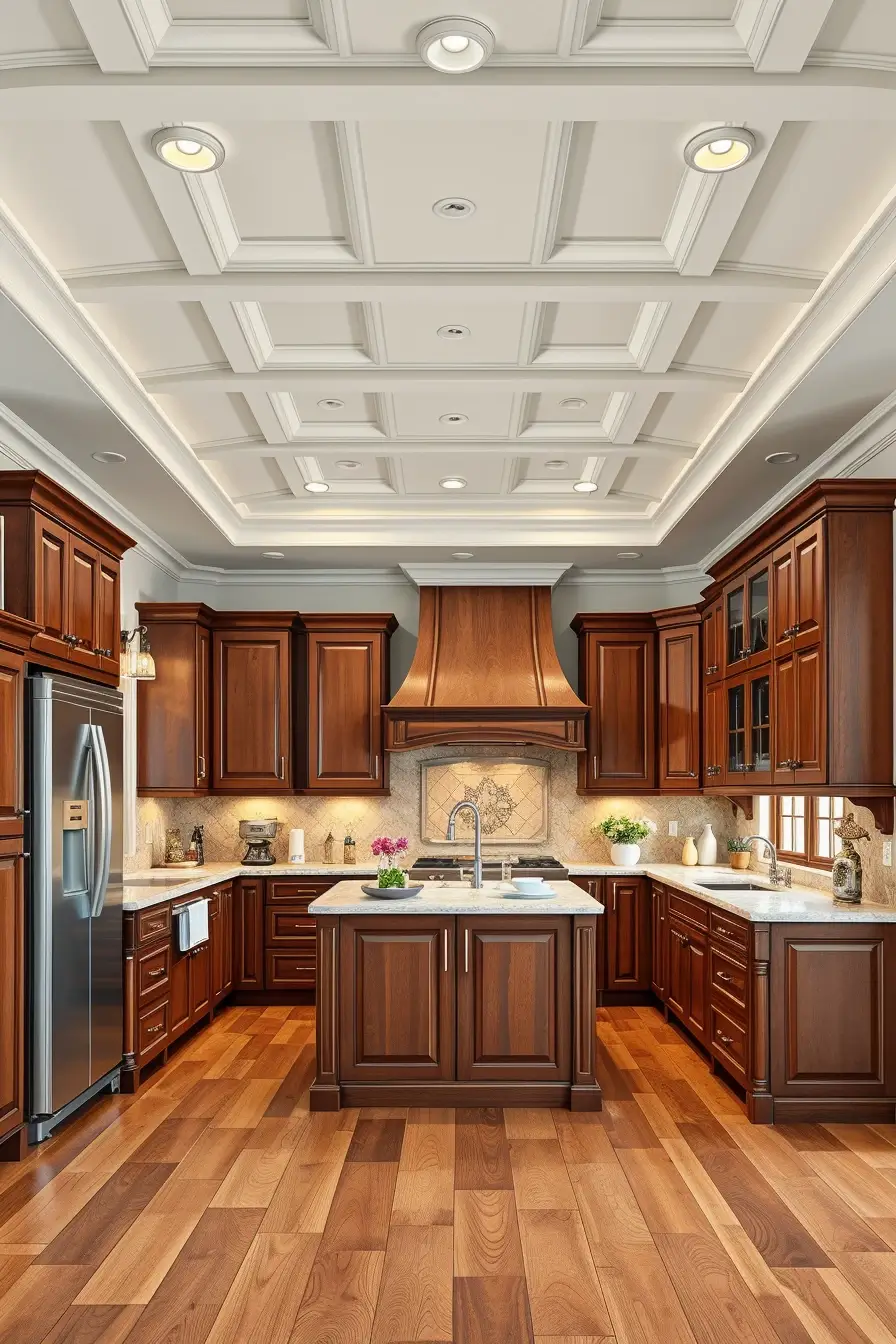
Have you been pondering over how to incorporate embracing brown kitchen ideas? Does brown spark your interest and you want to step up your kitchen space? It’s earthy color gives a comfortable feel , and can be used in a sophiscated way. In this article, I will show you multiple engaging interiors with brown accents be it cabinets or countertops and how to use them effectively. No matter the size of your kitchen or the style – contemporary or classic, you will find amazing ideas to create an inviting cooking area.
Every section moves on to a new design to discuss brown kitchens blending other textures, finishes, and styles together. Using everything from deep matte chocolates to richly toned walnut wood cabinetry, discover how to bring this timeless palette into your home.
Contempory Brown Kitchen Designs With a Sleek Edge
With the rest of the house in mind when designing brown kitchens, interior windows have come a long way from their rustic origins. I have completed a number of sleek kitchen designs where deep brown cabinetry blends with streamlined shapes, stainless-steel appliances, and stone accents. These designs are clear and functional, but still offer comfort. A cool undertone contributes to a modern appearance, especially when coupled with clean lines and built-in storage, as in the case of brown finishes.

Flat panel cabinets in dark brown finishes, devoid of visible hardware, tend to be my first choice. They achieve a uniform appearance best. A concrete-look backsplash or a quartz countertop breaks up the monotony of the brown while also providing some contrast. The entire aesthetic is softened by leatherette seat barstools with brushed metal bases. Their cold touch is modern, but not overly so. The minimalist profile of the pendant lights fixed over the kitchen island helps modernize the space.
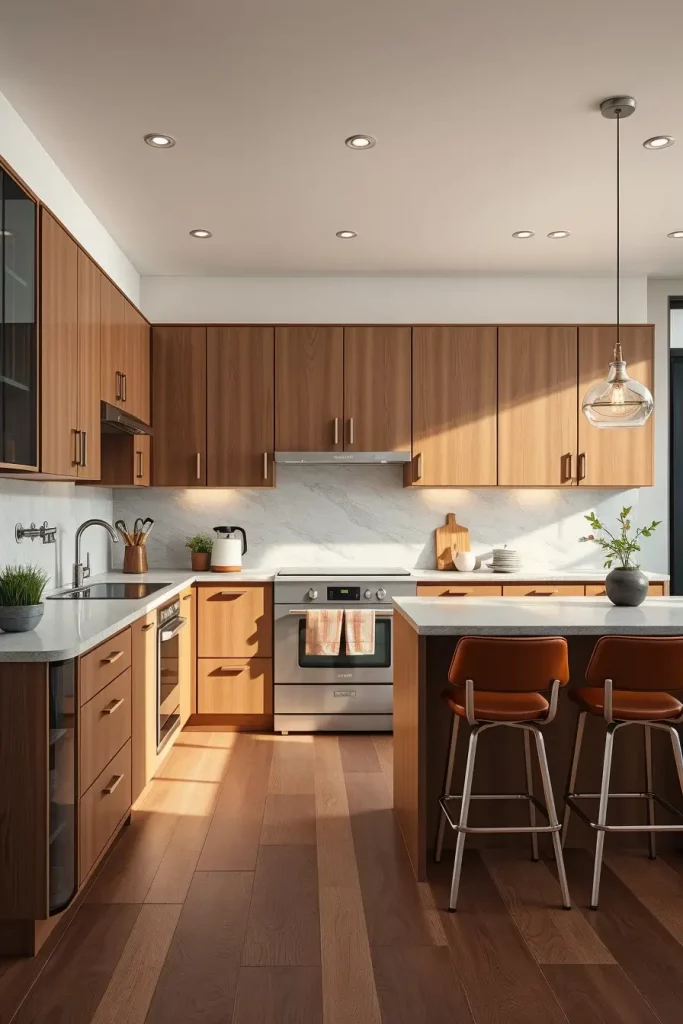
In my experience, homeowners are delighted by the sophistication of this layout style. Such an appeal without too much embellishment feels quite refined. As Architectural Digest describes, modern kitchens should feel personalized but not cluttered, and using rich brown undertones achieves this superbly. For me, the enjoyment comes from the way the color lifts simple forms and adds a sense of elegance devoid of brash hues.
To improve this view, I would recommend adding open shelving in pale oak or a neutral plaster accent wall to keep the brown cabinetry from overpowering the room.
Integrating White Details in Deep Brown Furnishing
There is visual movement and balance when using brown kitchen ideas combined with white accents. I have used this style in mid-size homes where the brown and white contrast works, and the client prefers a clean and warm atmosphere. Brown adds warmth and depth, while white introduces light and cleanliness. This works best in kitchens that do not have any windows.
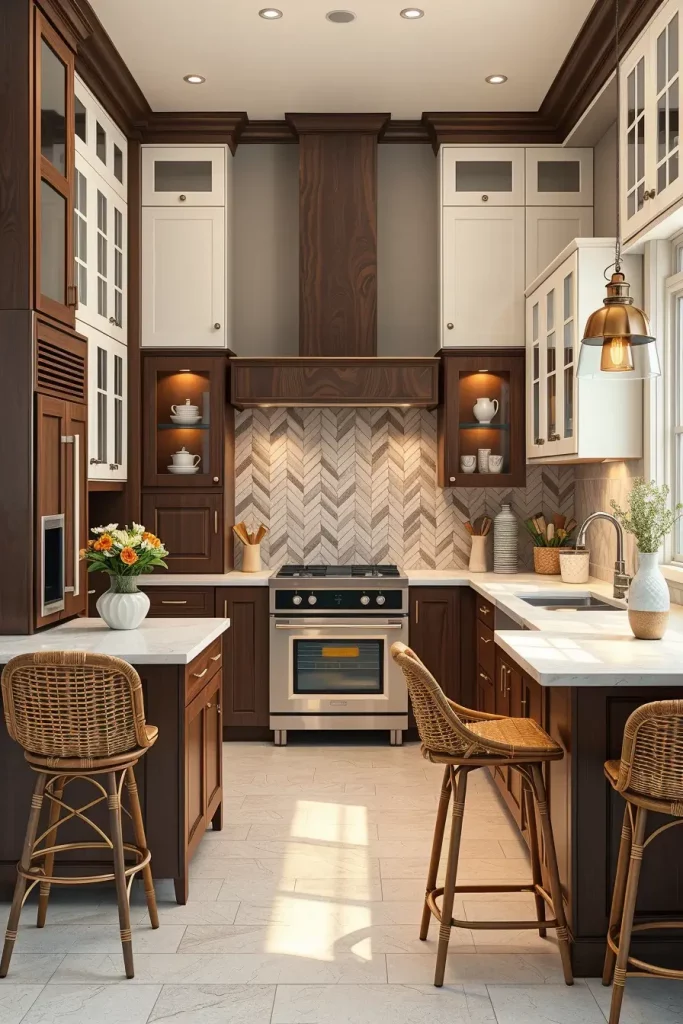
My designs begin with the lower elements featuring dark walnut or espresso cabinetry, then I add white quartz countertops, followed by white upper cabinets or floating shelves. A white tile backsplash adds pattern without overwhelming. To keep the white elements from feeling too stark, I use warm-toned LED lighting along with natural textures like wicker stools and linen Roman shades.
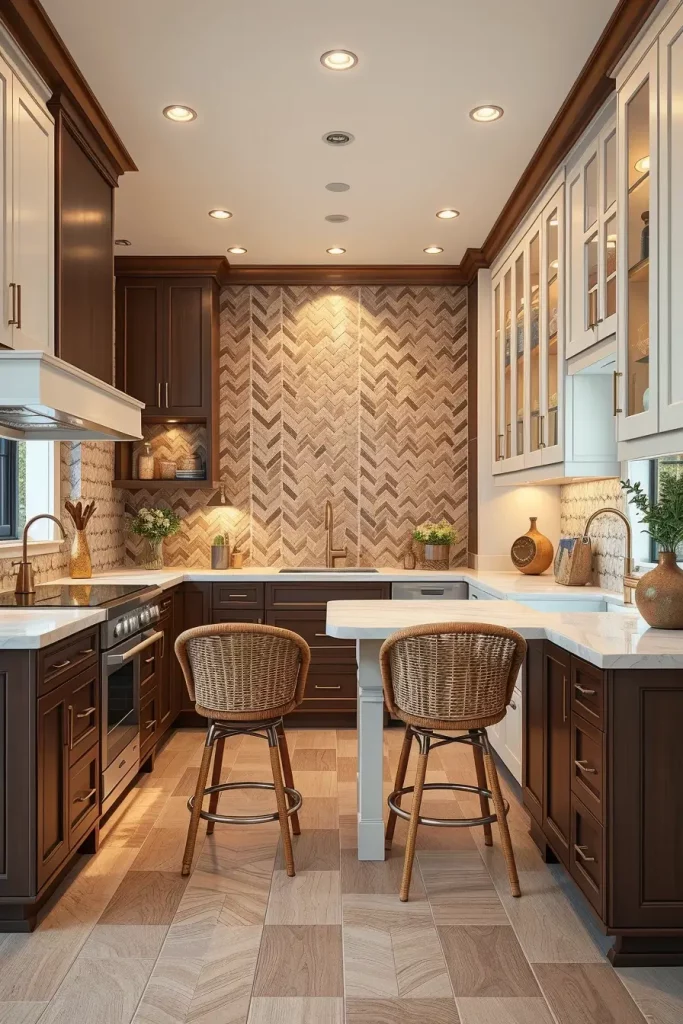
I consider this brown and white combination to be one of the most classic pairings one could think of. Visual interest is always high when similar hues are layered with different textures, and so does House Beautiful. When I did one of my recent remodels, the addition of a matte white range hood above a brown cabinet set transformed the perception of the space.
Brass or matte black hardware would perfectly add touch to the warmth of the brown and white splits, if I were to add something. It adds a lot to the character of the space but very subtly.
Elegant Walnut Cabinets for Contemporary Flair
Modern brown kitchens often incorporate elegant walnut cabinetry for its natural warmth and sophistication. Walnut’s distinctive grain and warm tone have always elevated a kitchen’s aesthetic, which is why I love it. It’s also versatile—its neutral mid-tone brown color can suit a lot of design styles: minimalist, Scandinavian, or even transitional.

In most designs, I incorporate walnut cabinetry for both the base and upper cabinets to achieve visual harmony. Integrated handles or push-to-open mechanisms maintain the wood’s seamless beauty. A matte stone countertop in taupe or pale gray additionally grounds the color palette, while the smoked glass cabinet doors add elegance and open some areas. For lighting, I usually place LED strips under the upper cabinets to illuminate the walnut grain at night.

As an example, walnut kitchens are a favorite for open house tours and design exhibitions. Elle decor designers often refer to walnut cabinetry as the perfect combination of sleek modernity and natural warmth. I have seen it charm clients who sought more neutral options.
Based on room size, I may recommend a vertical slatted walnut feature panel or a hidden pantry door to enhance aesthetic and practical value simultaneously.
Luxurious Feel with Brown and White Color Combos
With the right materials and layout, the combination of brown and white can result in truly lavish looking kitchens. I often suggest this color combination to clients who are looking for a timeless design with a hint of luxury. Searing white marble or polished surfaces will soften and elevate the rich depth brown holds.
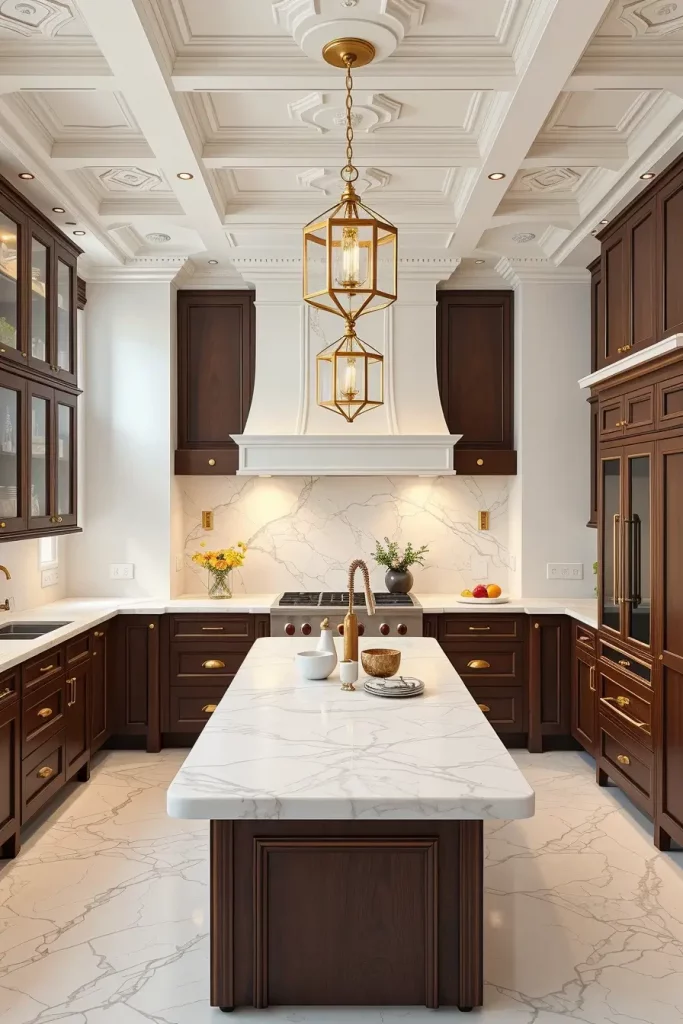
An example would be a full height white marble backsplash integrated with matching countertops placed over dark brown shaker cabinets. Crown moldings or a coffered white ceiling also elevate the trimmed drama and architectural detail. For that bolder look, oversized gold accented pendant lights above the kitchen island also add to that luxe style.

Elements of this combination are reminiscent of editorial kitchens featured in Veranda Magazine, which are sophisticated, bright and elegant without the clinical feel, but still overall balanced and easy to maintain in terms of style. Terriffic to achieve “rich yet airy” balance.
To perfect the look, paneling the appliances and installing a double wall oven would amp up the luxe feeling of a brown and white kitchen.
Creating Texture With Matte Brown Finishes
Matte finishes can create textural depth in brown kitchens ideas. This is particularly useful to me when the client wants a softer look without any shine or gloss. Brown cabinetry is best for contemporary apartments and urban loft kitchens as it provides a modern yet comforting feel due to its velvety touch.

Along with brown matte cabinets, I like to use honed granite or concrete countertops. For some variety, I might add fluted wooden panels to the island or side walls. Blackened brass for cabinet hardware provides some contrast and adds tactile variety. Under-cabinet lights add warmth which enhances the texture instead of washing it out.

In my opinion, this style looks premium for the fact that it does not draw too much attention to itself. As Dwell Magazine highlighted, matte finishes in earthy tones are transforming kitchen designs, and I completely agree.
To create more visual interest, I suggest adding a brown tile backsplash with depth to its patterns, or natural stone slabs for a seamless look.
How To Use Glossy Brown Cabinets for a Studio Apartment Aesthetic
While a matte finish can be chic, nothing compares to the luxury of sleek glossy brown cabinetry. In my experience, I recommend this type of finish on large, open-concept kitchens. This is because the light that bounces off surfaces glossed with brown adds an airy feel to the space. In addition, glossy finishes blend seamlessly with modern appliances and a clean, open layout.

In my designs, I usually work with white porcelain slab countertops and reflective glass backsplashes. With coffee brown slab cabinet doors boasting high gloss lacquer, chrome hardware, and integrated lighting, polished is the most appropriate description for the aesthetic. I like to avoid intricate patterned flooring that can distract from the cabinetry. Large format tiles or light oak planks do the trick.
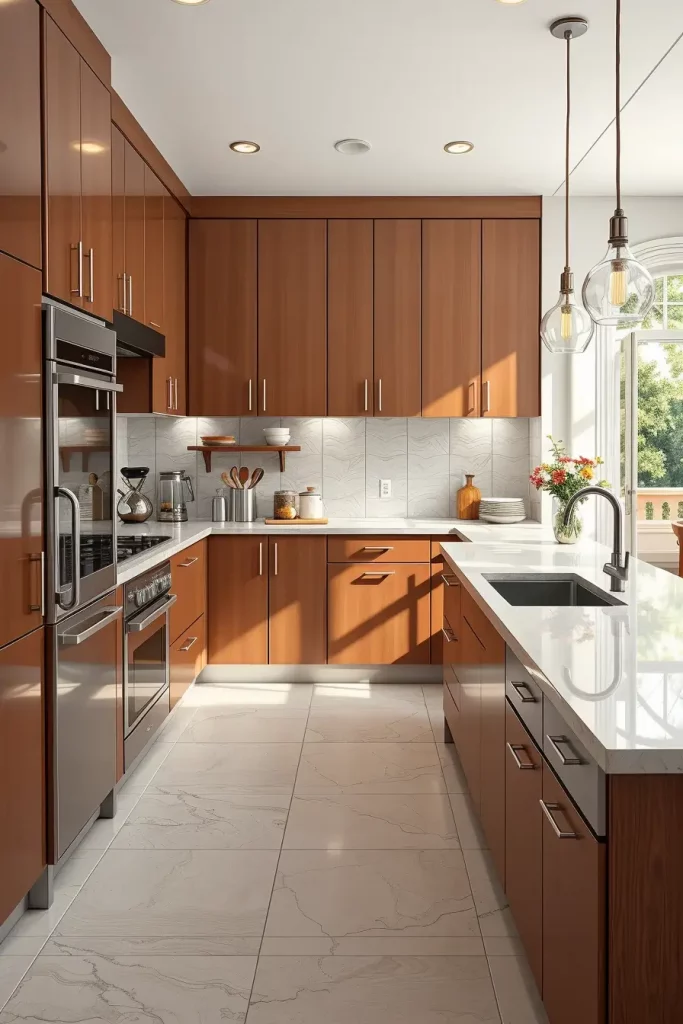
My clients are always impressed with the glamorous dimension and ultra-modern feel this finish provides. Urban home owners are tapping into the pentouse flair trend highlighted by Better Homes & Gardens and its no surprise glossy kitchens are back in trend.
For clients looking for additional suggestions, I would recommend a waterfall island of the same material for a seamless and cohesive finish.
Brown Kitchen Islands as Striking Centerpieces
A brown kitchen island can be both a working kitchen centerpiece and a style prop. This is something I recommend for open plan houses or spacious kitchens. It can be either stained wood or a painted brown, and the island can anchor the whole room while providing additional seating, storage, and surface area.

One scheme that I repeat often includes a richly colored brown island with white quartz or even Calacatta marble as a top. Stools with faux leather or woven seats provide visual weight and comfort. For added usefulness, I incorporate drawers, pull out trays, and concealed outlets into the island. Pendant lights with bronze or black matte accents complete the look.

To me, and many other designers, a robust island creates effortless gathering points around the home increasing social interaction which Brown Islands do better than whites. One of the things that HGTV designers pointed out is remarkable as well. A region bathed in natural light is perfect to place various stunning centerpiece arrangements.
If the kitchen size permits, I would integrate a section for open shelving or a wine cooler into the island to increase its utility and beauty.
Brown and Marble Countertops That Elevate the Space
In my experience, one of the best ways to elevate a brown kitchen is to add a marble countertop. The rich, earthly tones of brown cabinetry blend beautifully together with warm golden veins present in the marble. This combination gives the kitchen’s appearance a sense of timeless elegance, which is ideal for clients seeking an upscale yet undemanding appeal.

Usually, I suggest chocolate brown shaker-style cabinets paired with dramatically veined Calacatta or Arabescato marble countertops. The kitchen island with a waterfall edge can serve as a striking visual focal point. To maintain visual harmony, I tend to restrict the cabinet hardware to a minimum because with marble having minimalistic shine, it needs to be the hero of the design. Underneath the cabinets, warm lighting paired with brass fixtures deepens the lavish feel in the room.
In my opinion, marble adds artisanal charm and sophistication to the room while the brown cabinetry brings intimacy and warmth. As noted by Domino Magazine, combining bold stone with classic brown tones is becoming widely popular among high-end kitchens, and personally, I think it’s wonderful for my clients.
If I could make one addition to this setup, it would be extending the marble up the backsplash for a more seamless fit. This change would add high impact value to the space and visually connect the area. It unites the workspace and adds cohesion within the marble.
Combining Brown Wood With Minimalist White Walls
One of the most effective brown kitchen ideas I like to implement is pairing brown wood with minimalist white walls. The natural beauty and texture of brown wood really shine through without making the space feel heavy, cluttered or overly busy. It’s something I do in smaller kitchens or in open-plan homes where the kitchen flows into the living room.
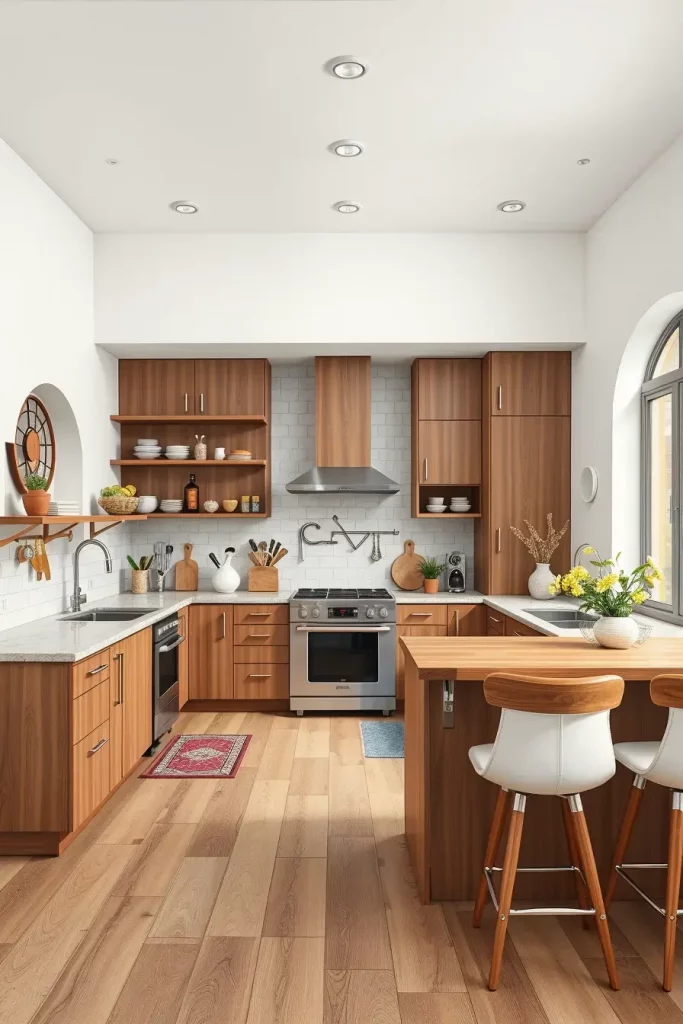
In this instance, I like to use mid-tone brown wood—such as oak or teak—for the cabinets or flooring and the walls, ceilings, and trim in the other regions to be bright white. To bring the entire piece together, open shelves are mounted in the same warm brown. For the seating, I opt for white barstools with wooden details while balancing the rest of the room featuring stainless steel appliances. Other decorative elements need to be kept understated— a singular ceramic fruit bowl or a matte black faucet would do.
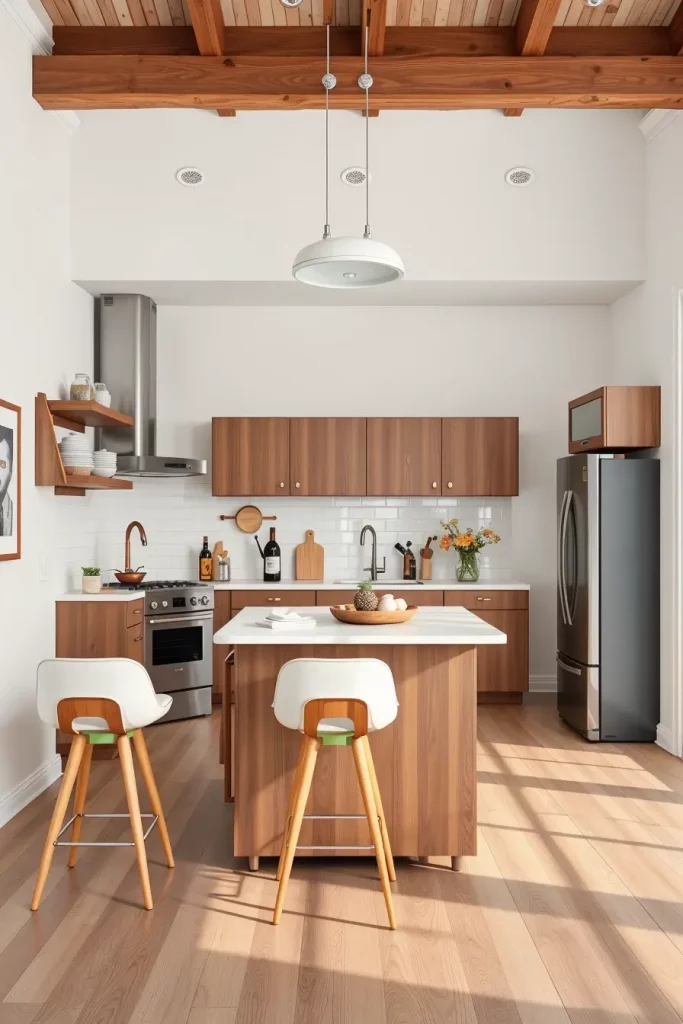
This method of contrast is something I first came across studying Scandinavian alongside Japanese interiors. Dwell and Dezeen usually showcase this mixture, as it is timeless, airy, and uncluttered, not necessarily sterile. Homeowners seem to like this approach because it allows personalization with seasonal decorations.
In my opinion, enhancing the visual intrigue with white wall art or soft vertical shiplap would suit this style. The addition of these details to the design’s blank spaces alleviates minimalism while preserving the design’s understated aesthetic.
Adding Luxury Touches With Bronze and Copper Hardware
A brown kitchen can be lifted best with the addition of bronze or copper hardware. It has a way of warming up and enriching lighter or darker brown finishes. I’ve done this in kitchens that want to evoke understated luxury, but not through the use of bright colors or strong patterns.
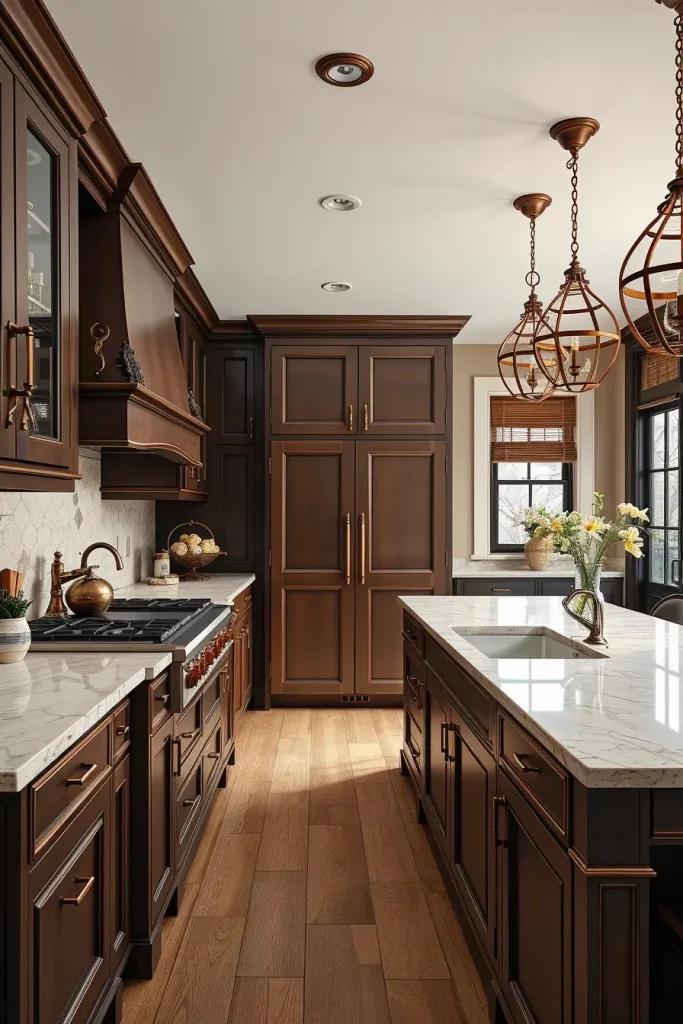
For instance, I suggested espresso cabinets with antique copper pulls, hammered bronze light fixtures, and a matching faucet. These elements may initially appear insignificant individually, but collectively, they possess the power to transform the entire aesthetic. As I mentioned before, they couple well with quartz or soapstone counters, with the addition of balance-creating pendant lighting that unites all the components. The best fit for the surface of the hardware would be a satin or matte finish, as these add modesty and refinement without overwhelming glare.
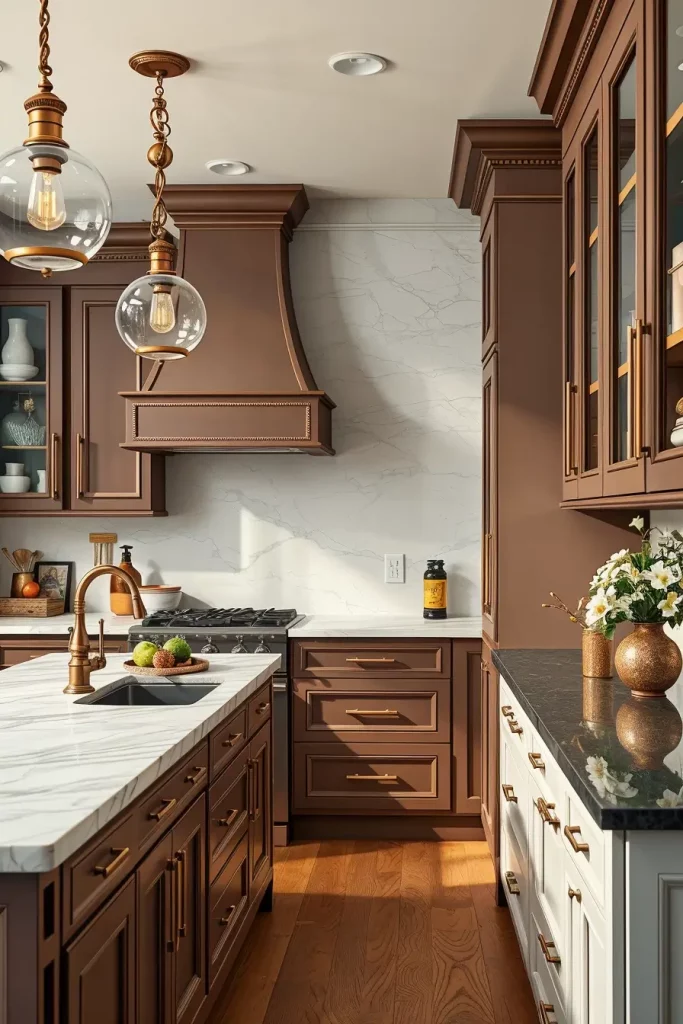
For my clients, I personally witnessed the bronze or copper elements create warmth in kitchens that flow into other brown-infused living space. Better Homes and Gardens noticed this as a welcoming trend marking a return of tactile coziness modern homes, and I tend to notice more and more clients loving how much warmth it brings.
If I were to elaborate further on the issue, I would recommend introducing bold copper matte-black pieces, while integrating them throughout the space in a visually coherent manor, tailoring everything to one set standard so as not to cause distractions.
Moody Espresso Kitchens With White Lighting Accents
A carefully balanced layered white lighting effect will always provide drama to an espresso kitchen. (Add) The effect of espresso finishing coats creating an cocoon effect in a room is remarkable. It feels modern and soft at once.

In this project, I fabricated components out of espresso stained wood and even lacquered espresso panels. Shadows are softened by upper cabinets and floating back-lit led strips. The visual effects of the space are lightened with white and ivory barstools. The ivory barstools and some glass doors on cabinets lighten the room’s visual weight. Deeper hues are blended perfectly with quartz countertops in soft white and light gray veining.
These contrasting elements together create a middle ground that is practical, calming and intriguing all at once. I first saw this in an apartment moody boutique kitchens in luxury city lofts. These style was featured in Elle Decor magazines espreso kitchens with white lighting as a must for a warmer homes with a masculine touch. I also saw this accomplished for people who love remembering warmer, gathering- friendly evening settings.
Maybe adding dimmable ceiling spots or a modern white chandelier that both “softens and complements” the moody tone would work while remaining “functionally brilliant.”
Enhancing the Brown Kitchens with White Ceilings
From my experience, I have come across various designs with a brown kitchen. They always seem to work best when there are white details on the ceiling. From beams that are left open to boxed-in white drywalls, these features always seem to make the space feel more open. This is perfect for spaces that have shorter walls or fewer windows that let light in.
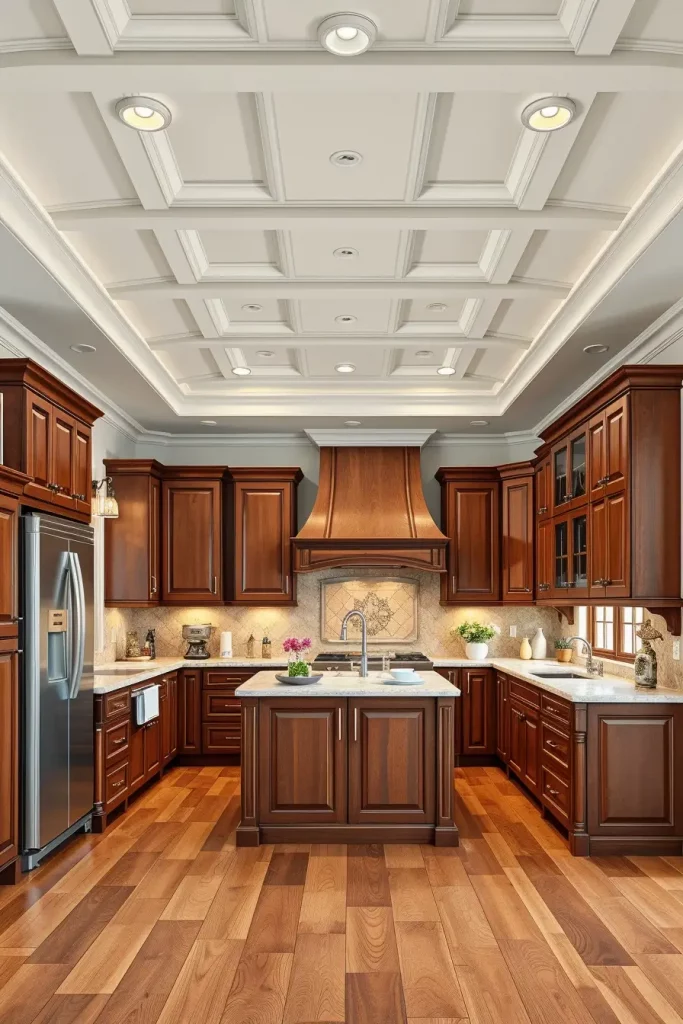
One of my favorite looks has deep walnut cabinets paired with a white wood-planked coffered ceiling. A coffered design with recessed lights creates an inviting atmosphere and a flat white ceiling is very sleek and modern. I like to spice it up with some crown molding or ceiling medallions for a hint of classic depending on the style of the house. This combination always adds a sense of classic elegance without overwhelming the space. The white contrast with the brown tones underneath allows for an illusion that gives height and spaciousness.
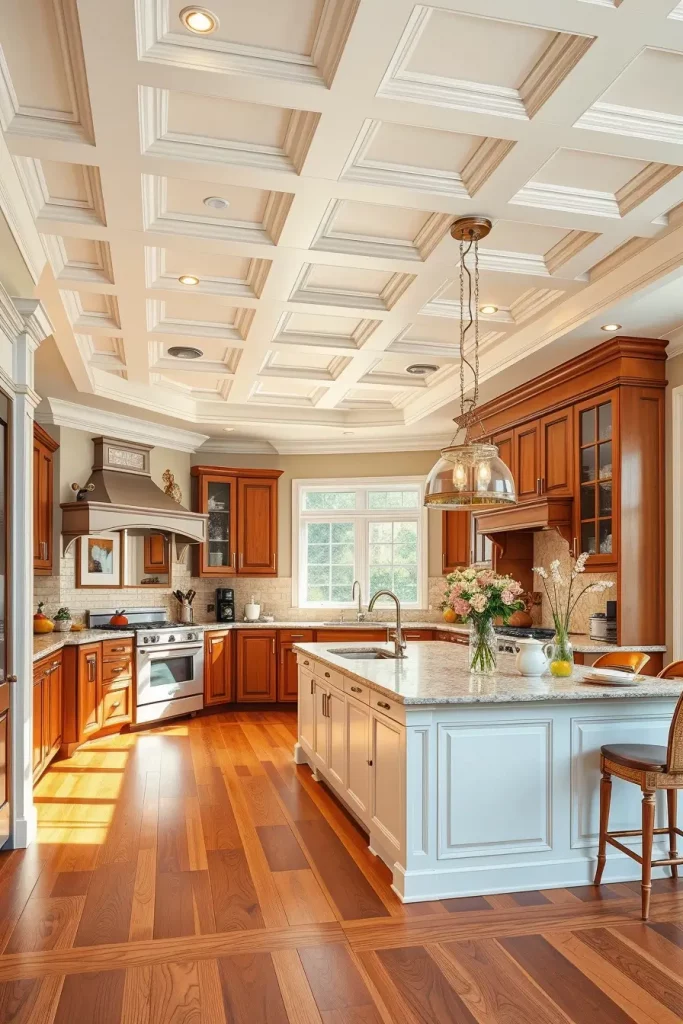
Decorative or not, a bright ceiling impacts the whole atmosphere. Following HGTV experts, I now always recommend using it to reflect light instead of caving into the dark cabinet overpowering the room. So many spaces I have worked on simply needed a brighter ceiling and some new light fixtures to make everything else pop.
For the next step, I would recommend softening the white tone further with decorative crown or light upper cabinetry to form a tiered transition from the ceiling to the base cabinets and improve synergy within the area.
Warm Modern Vibe with Mid-Tone Brown Cabinets
Brown cabinets with mid-range tones are some of the most useful options in kitchen design as they create an inviting warm feeling whilst still being modern. This is a tone I often recommend to clients that seek something softer than espresso and more deep than beige. It works well for an inviting yet sophisticated cooking space.
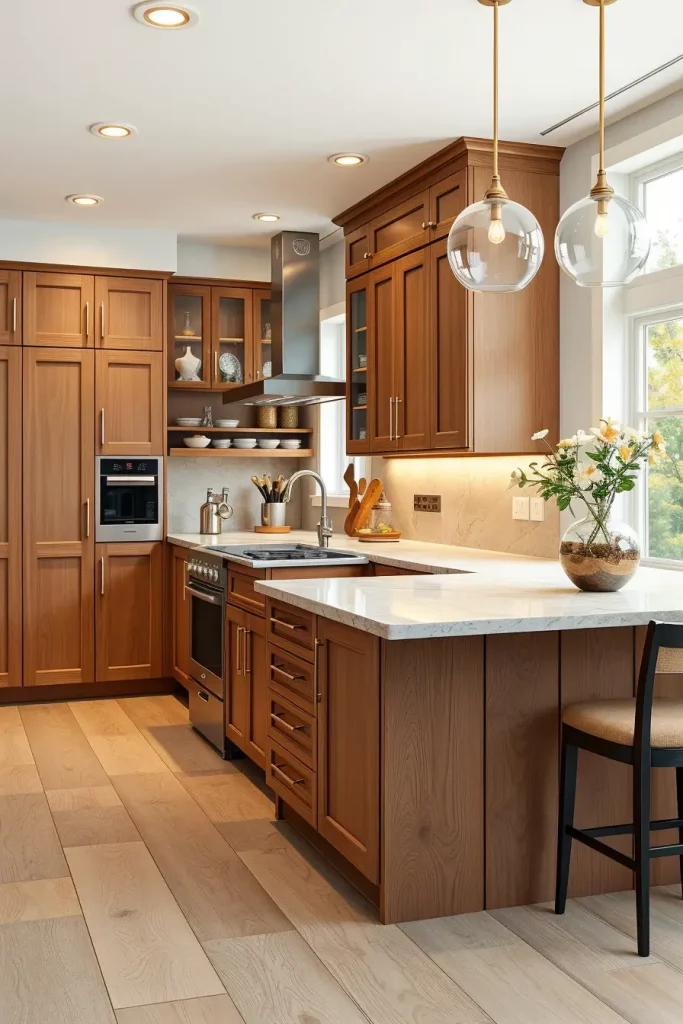
I particularly love using wrought oak or walnut for flat-front cabinets and these colors. Off-white or sandy stone countertops create a beautifully cohesive palette. Flooring should be a bit brighter, either a lighter wood, sometimes even large format tiles. With it, bright but subtle, minimal, appliances fill the room alongside brush nickel hardware. The cabinetry takes the lead in design and ideally placed brushed.
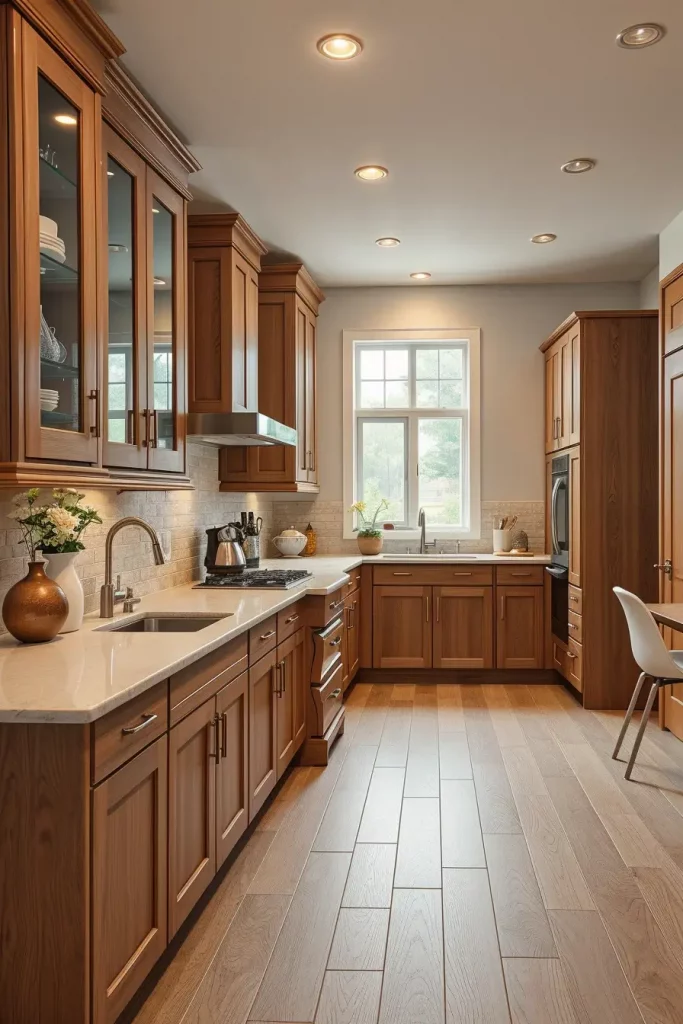
I’ve observed that families and people who wish to settle down in one place for an extended period are usually captivated by mid-tone brown. “A new classic” as described by Veranda Magazine, would likely outlast trendier hues, and from my work, I absolutely corroborate. Pairing the color with seasonal decor is relatively less complicated.
I would suggest trying two-tone cabinets in this color scheme, perhaps sage or ivory for the brown base, to retain warmth while adding even more depth.
Chic Chocolate Brown Kitchens With Bold Contrast
Chocolate browns provide an elegant and neutral base to work off with bold design contrasts. This is a color family I enjoy working with because it yields a dramatic look without going too far over the top. Using strong contrasting elements like bright white, black, or even brass creates a balanced sophisticated feel.
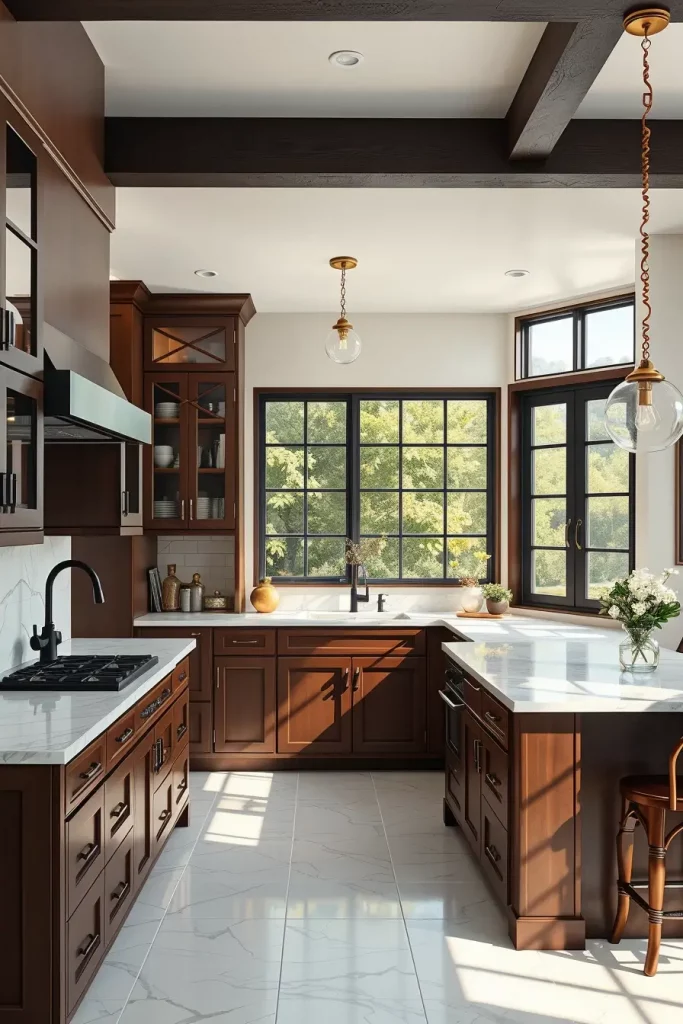
For this look, I usually create designs with flat-panel chocolate brown cabinets and a bright white marble countertop. Brushed brass or matte black are my go-to choices for adding contrast with the decorative elements. A pendant light with a sculptural gold graphic detail adds modern elegance. Large glass doors or black windows are some of the other features I love to use for framing the space while bringing in natural light.
Based on my experience, clients who prefer chocolate brown like its sophisticated charm alongside a unique spin on brown kitchens. Architectural Digest illustrates this color as ‘the new neutral’ which fits urban living and upscale remodels beautifully, calling it ‘chic’ while bold. It’s bold, but it never feels like a fad.
To further these thoughts, I would propose a dark wood floor with a subtle grain or adding a custom color matching bookcase to bolster the richness within this space.
Captivating Brown and White Backsplash Designs
From my experience, a brown and white backsplash adds charm to the entire kitchen. It simultaneously sets an inviting tone. I appreciate backsplashes that have patterns or textures big enough to add some character but not so large that they overwhelm the designs around it. In open-concept kitchens, the backsplash acts as a focal point, so I strive to find tile patterns that bring opposing forces of contrast and balance.

For the brown section, I typically combine it with either honey or walnut-toned tiles and pair them with crisp white subway tiles or marble mosaic inserts for the contrasting part. The color of the grout also matters; dark grout around white tiles gives a defined look while light grout looks more airy. Pot fillers in brass or matte black also serve as color distractors, which makes them great for accent pieces.
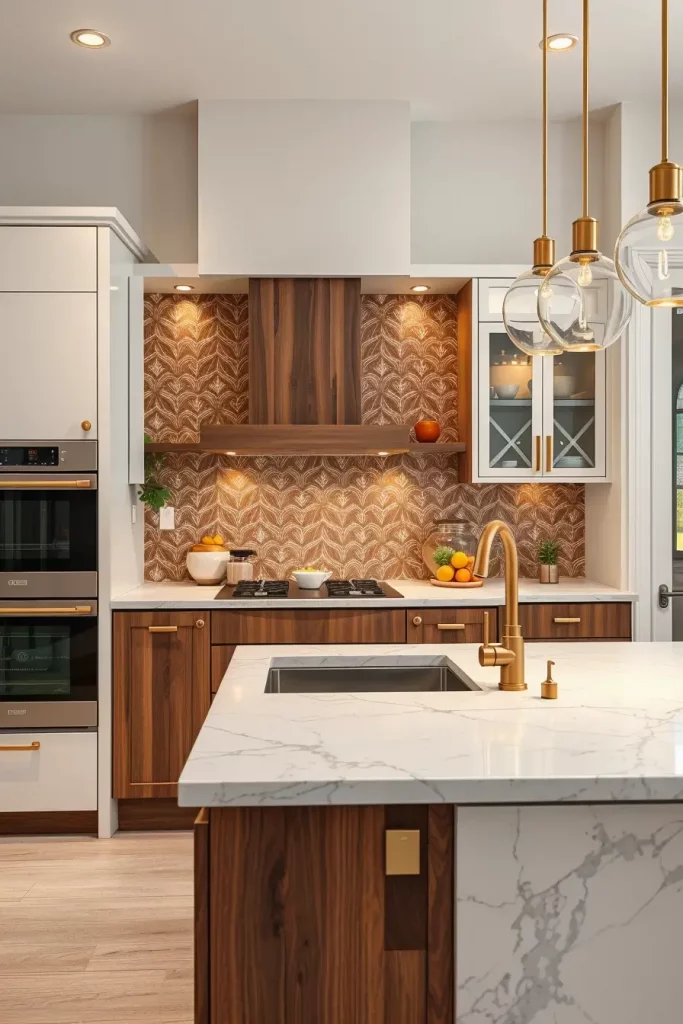
Personlly, I find a brown and white backs plash to appeal aesthetically with nearly any cabinetry, regardless of the modesty. One of my clients used Moroccan-style brown tiles with creamy white ceramic squares woven in, instantly transforming her small kitchen into a boutique-worthy space. As Elle Decor states, backsplashes are often overlooked by many people but enhancing them is a remarkable way of sprucing up the entire kitchen.
An additional consideration for this section would include the discussion on lighting. These contrasts, as well as the depth of the evening ambiance, could be achieved with under-cabinet lighting or backlit panels behind the glass backsplash tiles.
Sophisticated Brown Kitchen Layouts for Open Spaces
In regard to open spaces, I find brown kitchen concepts particularly appealing as they visually ground an area. Wood tones serve as an attractive focal point that defines spatial boundaries without walls. In open layouts, I generally go for mid to dark wood paneling, and it’s always well-tailored, so the aesthetic flows into surrounding spaces.
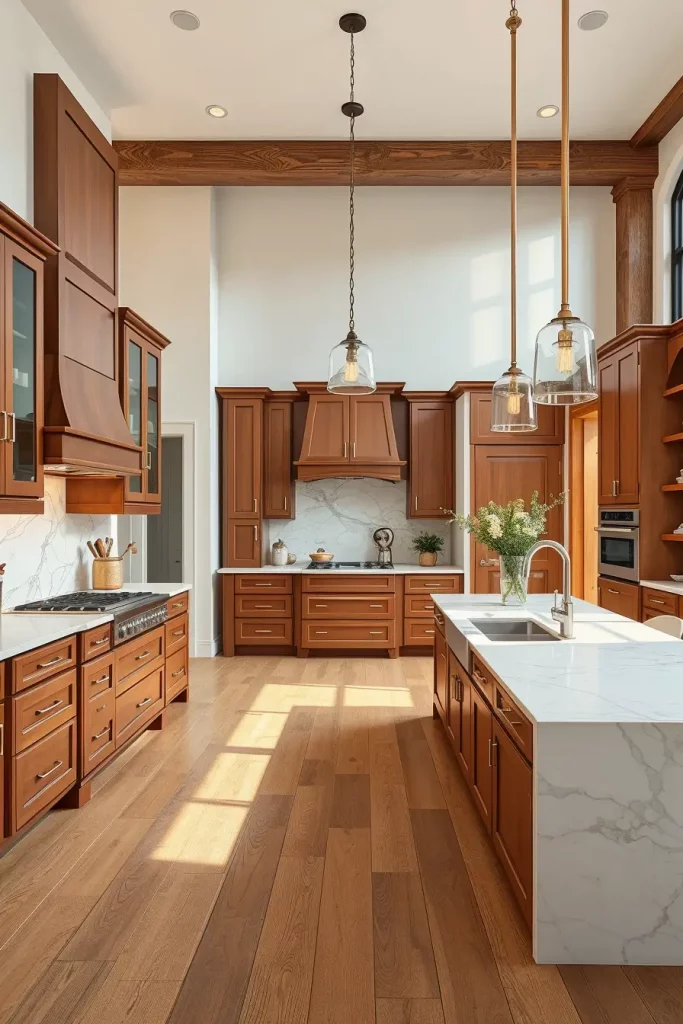
In open designs, a U-shaped or large island-centric layout works marvels. To bolster the subdued feel, I often use walnut for the lower cabinets and then pair them with white wall-mounted cabinets or open shelving, elevating the aesthetic. Glass pendant lights and brushed nickel hardware enhance the subtle sparkle. The warm wood or whitewashed tile flooring seamlessly flows through the spaces and unifies the design palette.
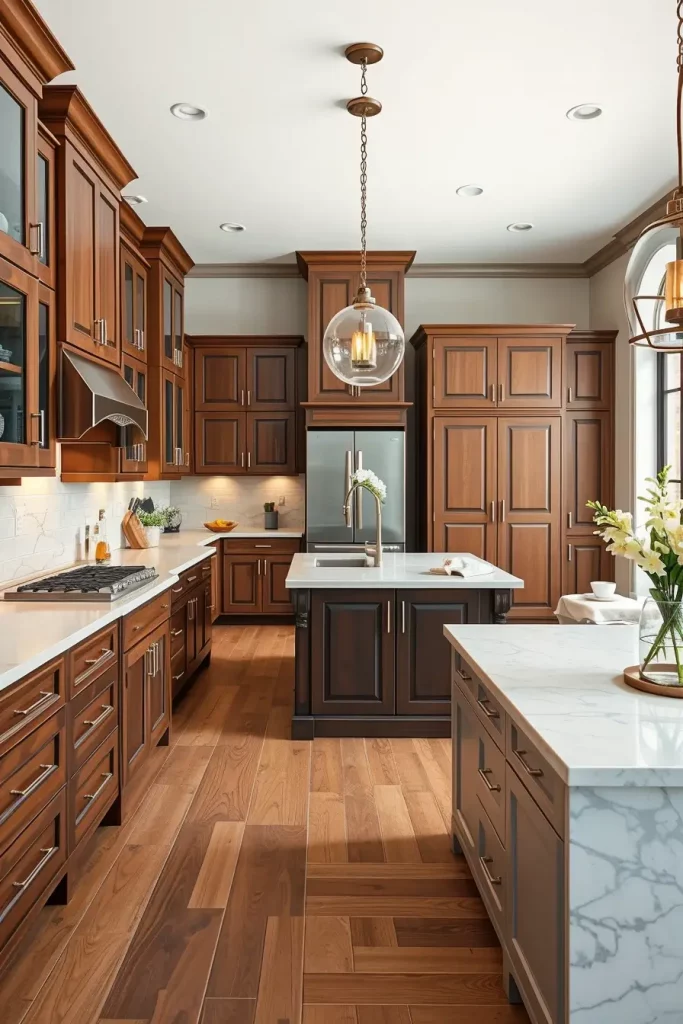
I have noticed that homeowners like how brown hues for cylindrical spaces offer a symmetry of practical use and style. Whenever the cabinetry integrates into the dining areas, lighter tones or glass-front doors serve to alleviate some weight. An article in Architectural Digest indicates that darker cabinets are coming back, especially with the feature of neutral tones layered to create a balancing effect.
This text could also be improved by integrating some ideas on how to conceal appliances in open spaces—panel-ready dishwashers or integrated refrigerators offer great value in terms of design and flow.
Polished Elegance with Natural Wood Joined with White Marble
Natural wood with White marble is one of the most sophisticated combinatons that brings a refined appeal. The marble’s crispness combines beautifully with the organic wood grain which warm it, therefore feeling grounded. Both modern and transitional kitchen designs can benefit from this duo due to it being able to straddle both styles seamlessly.
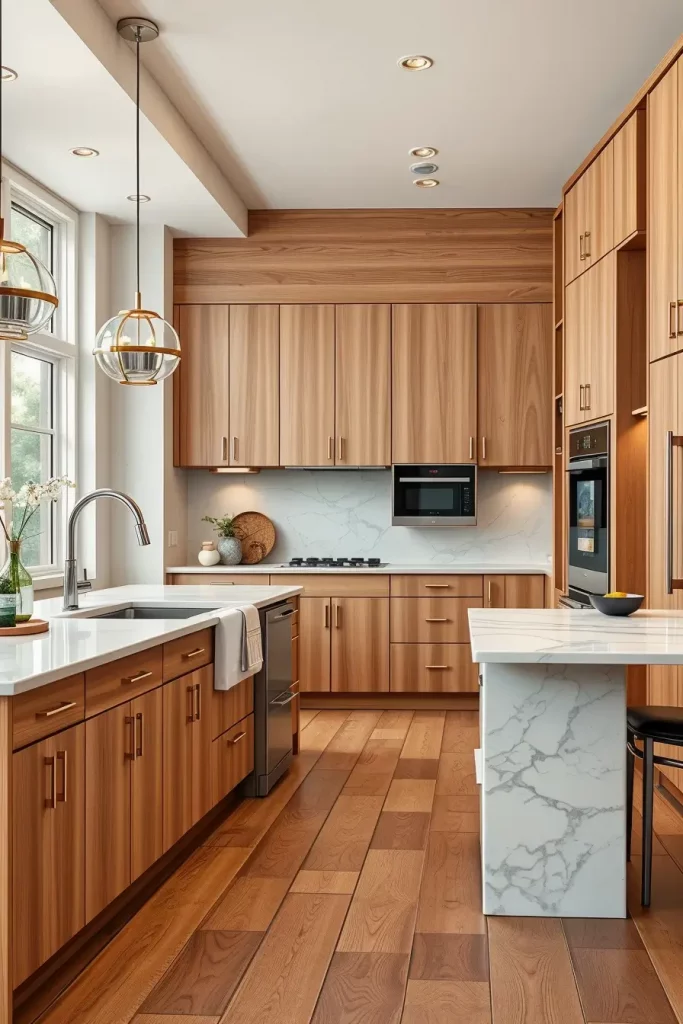
In terms of furniture, my go to is solid walnut or oak cabinetry with matte finishes with honed white marble counters and backsplashes. Waterfall marble island edges serve as sculptural elements, and rustic chic style is enhanced by wood-framed open shelves. Polished chrome fixtures do not steal attention, but work seamlessly with the show-stopping stainless steel appliances.
In my view, this combination provides enduring aesthetic value and flexibility. One of my clients described her remodel as feeling like a culinary spa, and I think that was the case because the warmth of wood blended with marble cooled the room. Better Homes & Gardens seems to feature this combination on their best-of kitchen lists for it’s timeless nature.
To take this combination even further, I would add soft lightings such as bathed globe pendants or dimmable sconces to accentuate and make the marble shine while the wood gleams.
Streamlined Brown Kitchens With White Floor Tiles
If you are a minimalism enthusiast, I have come across sleek brown kitchens paired with white floor tiles, which provide a modern yet warm feel all at once. For smaller houses and apartments, the difference between the cabinet and floor reduces the chance of making the area feel too heavy.
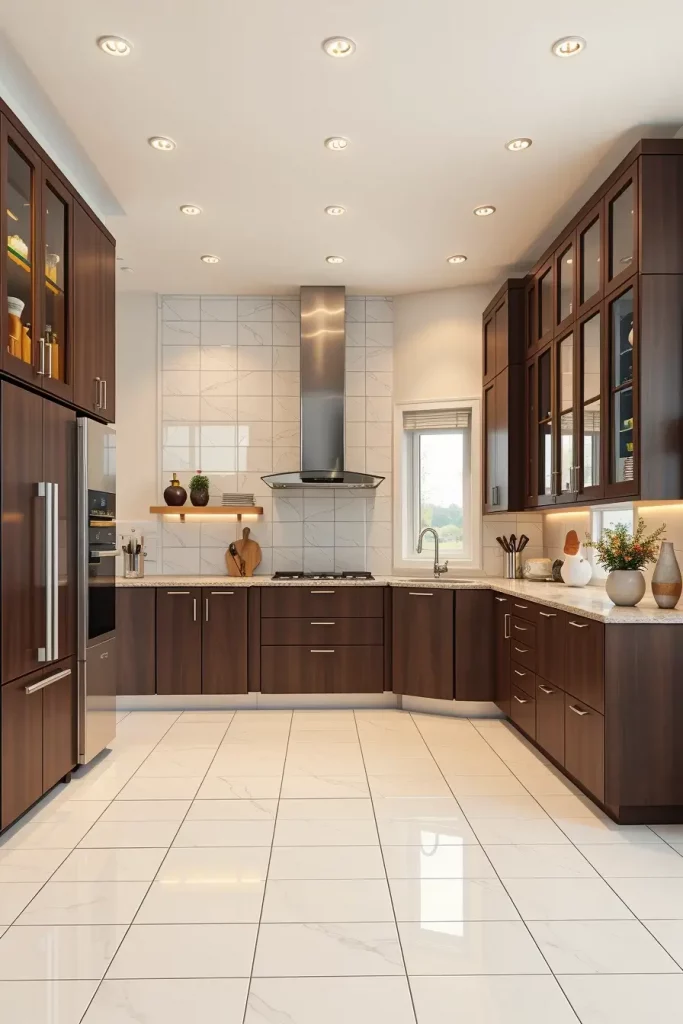
Here, flat panel cabinetry in espresso or walnut works beautifully with white porcelain or matte ceramic floor tiles. Light grout can introduce pattern without overemphasizing the cabinets. To improve the lines, I frequently incorporate subtle flush mounts and handleless doors with slab countertops. The area is also efficient as, waterproof led’s integrated into the cabinetry strategically shine to provide light where needed.
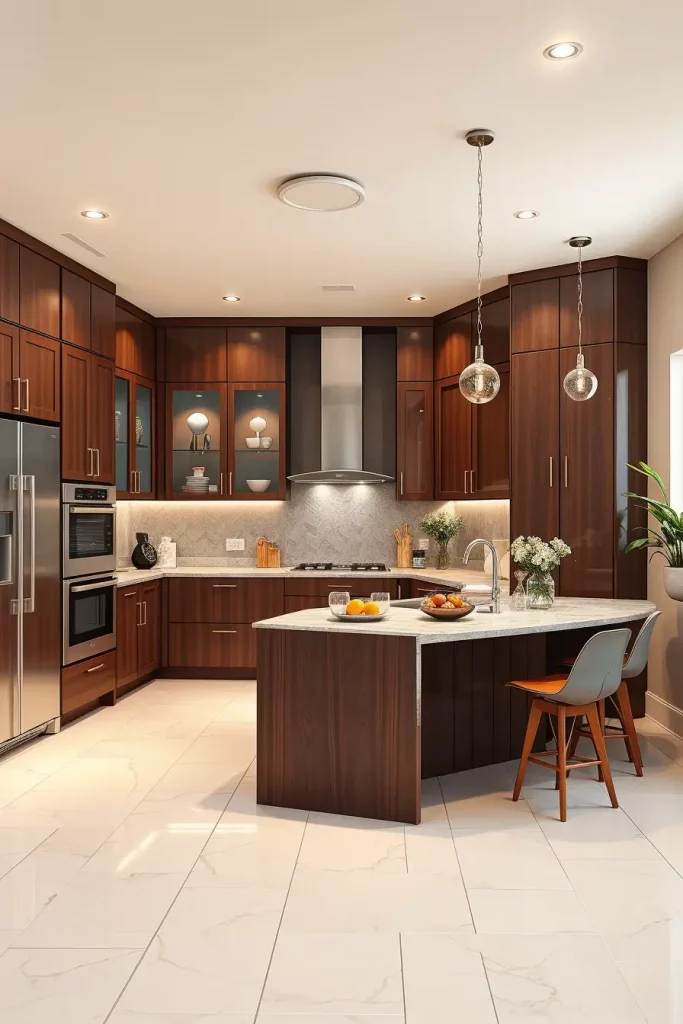
A client of mine once tried to achieve elegance without clutter in a down town condo. This approach to design expanded the feel of the kitchen and made it brighter and modern. I have read in House Beautiful that streamlined kitchens are among the most popular with professionals and city dwellers because of their polish and effortless style.
Adding some warmth through a wood-slat ceiling detail or a textured backsplash could add interest by offsetting the smooth finishes.
Polished Brown Interiors and Statement Lighting
Overlooked all too often, lighting plays an essential role in kitchen design and prevents brown interiors from a dim look. I suggest using statement lighting as a focal point to draw the eye, such as a linear chandelier over the island or globes grouped together in brass or matte black.
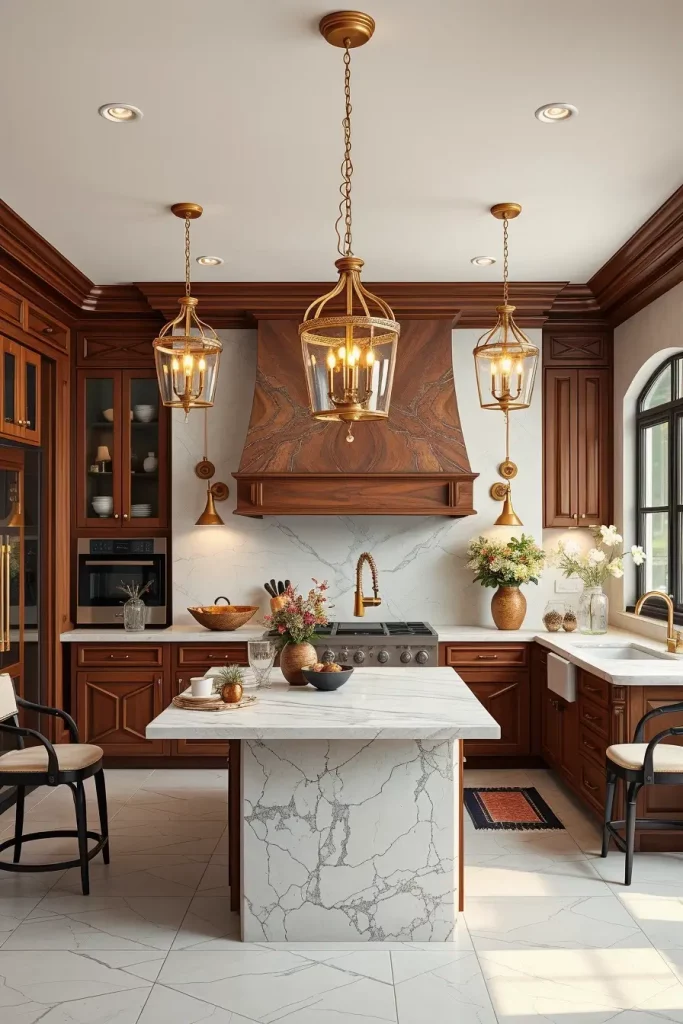
As I put together the space, I like to combine the lighting with other metal finishes, with bronze hardware and gold-toned faucets or even a black hood vent all interacting well with the light’s finish. In our brown interiors, oversized pendants with smoked or amber glass lend a retro modern feel while providing ample soft, diffused light that the depth of brown enhances.
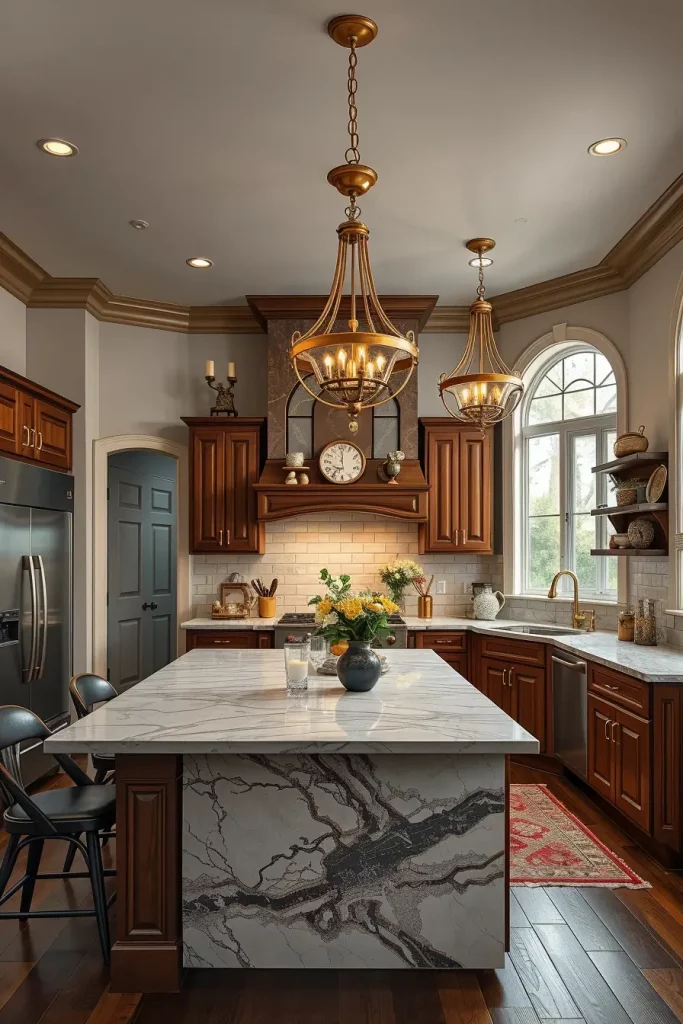
Through my work, I have witnessed the ‘before and after’ transformation of a kitchen with the right lighting fixture. One of my clients selected a branching sputnik chandelier in antique brass, which provided an artistic enhancement to her brown kitchen. This color palette has beautiful brown hues showcased by The Domino Magazine styled with these lights.
To keep it adaptive, I may also put in a dimmer switch for mood lighting. This feature allows effortless transition from cooking to entertaining for the homeowners.
White Countertops on Rich Brown Base Cabinets
A combination I keep returning to for kitchen remodels are white countertops with rich brown base cabinets. This approach looks good in small and large kitchens because it’s timeless. It gives space for the lower cabinets to serve as visual focal points while the upper half remains light and open.
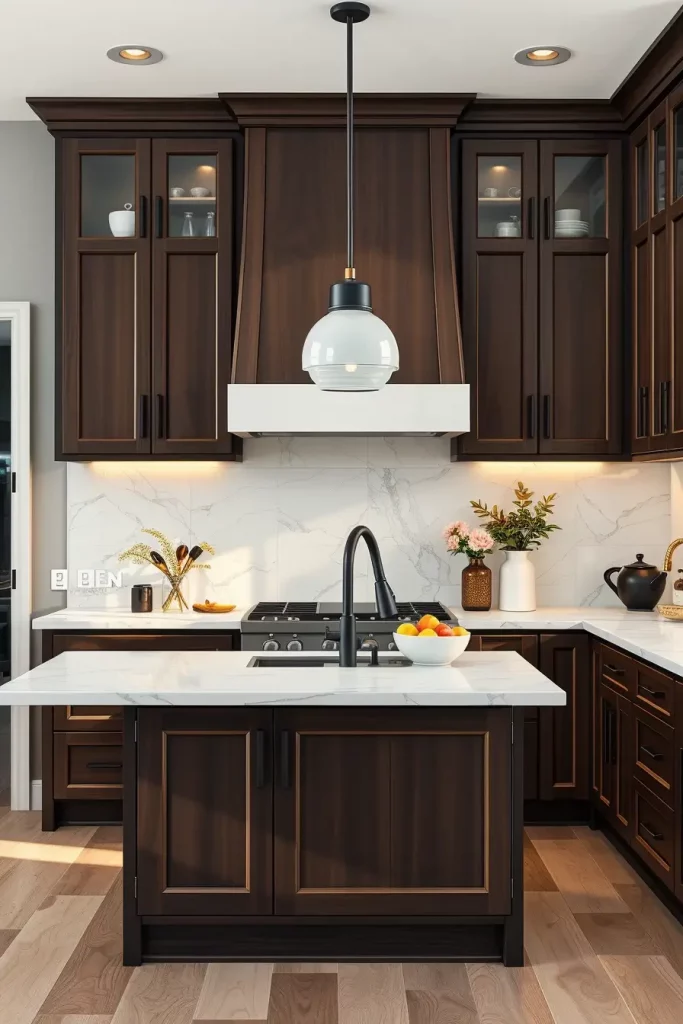
I typically go for quartz or marble in bright white with soft veining for the countertops. Base in espresso, chestnut, or even cinnamon-colored wood creates a warm and sophisticated vibe. I prefer these with brushed nickel or matte black. I like to place the countertop on a peninsula or island to increase the seating and food preparation space, which further enhances the functionality of the kitchen.
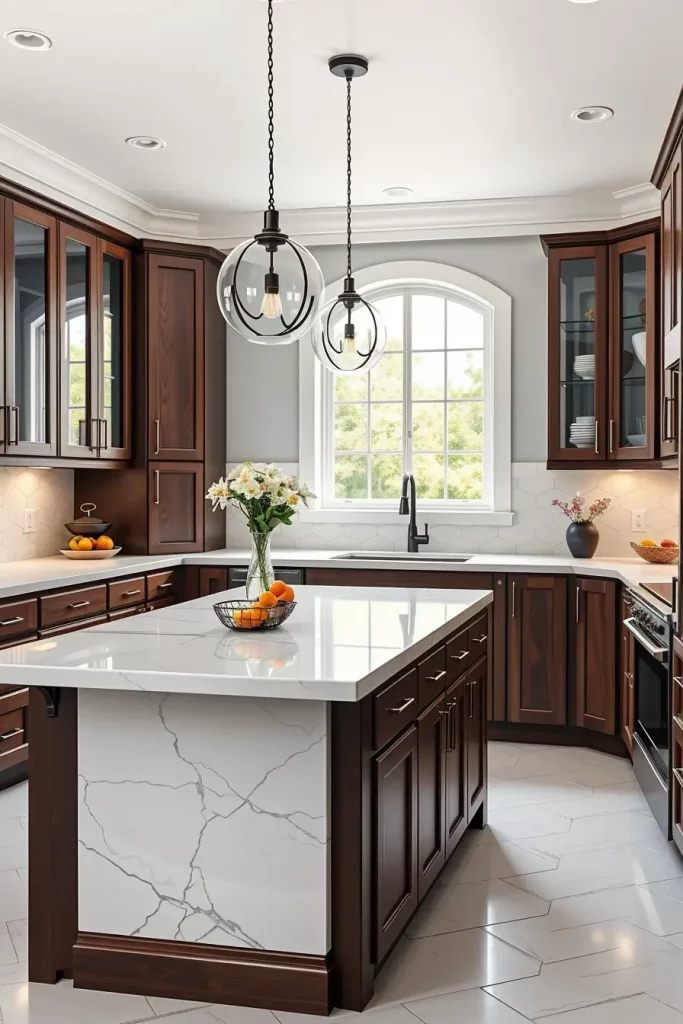
In my experience, this pairing always works. It is a reliable method to meld old and new styles. HGTV design expert Emily Henderson referred to this combination as, “one of the most versatile kitchen palettes,” in her designing overhauls.
If you are using a cabinet stack that shows some wall space, consider using a short white backsplash to complete the look and pull everything together.
Integrating Brown Leather or Suede Bar Stools
A great way to add comfort and texture into the kitchen is by adding brown leather or suede bar stools. Their addition provides great texture while being effortless. Bar stools work best in island centered or open concept layouts as they serve as a centerpiece. I tend to prefer smooth backs and black or brass legs because of the modern touch.
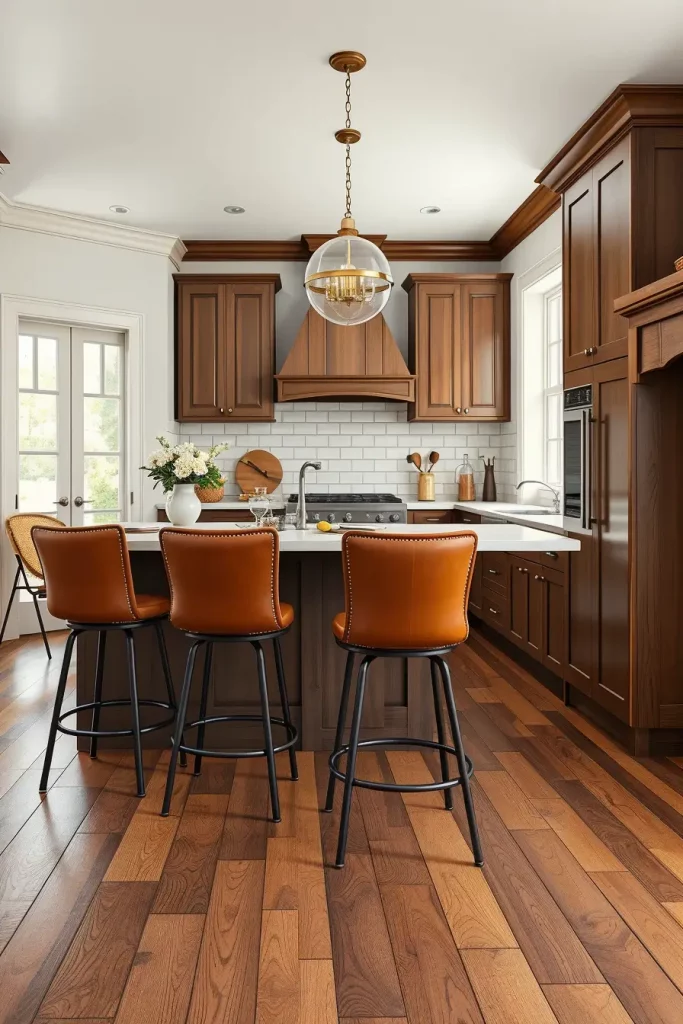
The type of material is very important; top grain leather and soft touch suede stand up to daily wear and tear. Depending on your needs saddle, bucket, and backless stools all have their place. For balance, I usually recommend caramel, chocolate, and taupe shades that match the cabinetry and flooring.
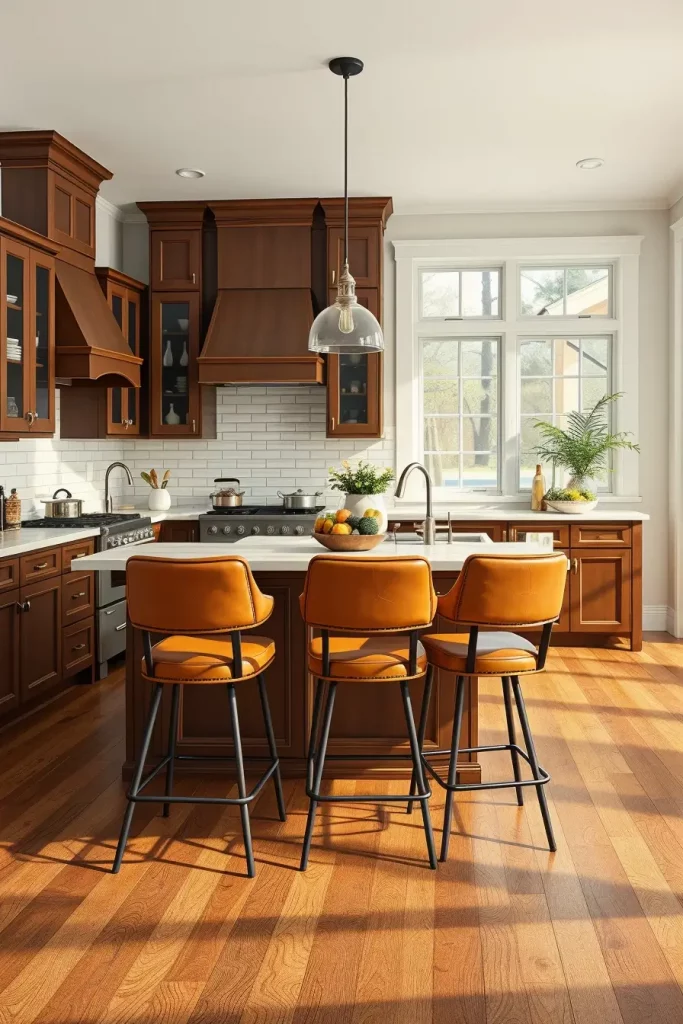
On one of my favorite remodels, we paired saddle-brown suede stools with matte black legs. They made the kitchen feel like a warm, boutique hotel. As I read in Dwell, tactile seating is gaining popularity and offers visual softness and modern ergonomic support in upholstered furniture.
To enhance the look even further, adding a woven rug under the stools would work, or installing under-bar lighting would create additional mood lighting for entertaining in the evening.
Range Hoods that are Like Sculptures
I like to recommend a standout feature for brown and white kitchens, which is sculptural range hood. In this case, they function as both practical appliances and art masterpieces which raise the space up to the next level. You can have these hoods in-built or free standing hence they provide depth, character, and fashion. I usually choose a hood that cohesively matches with both the cabinetry and backsplash.
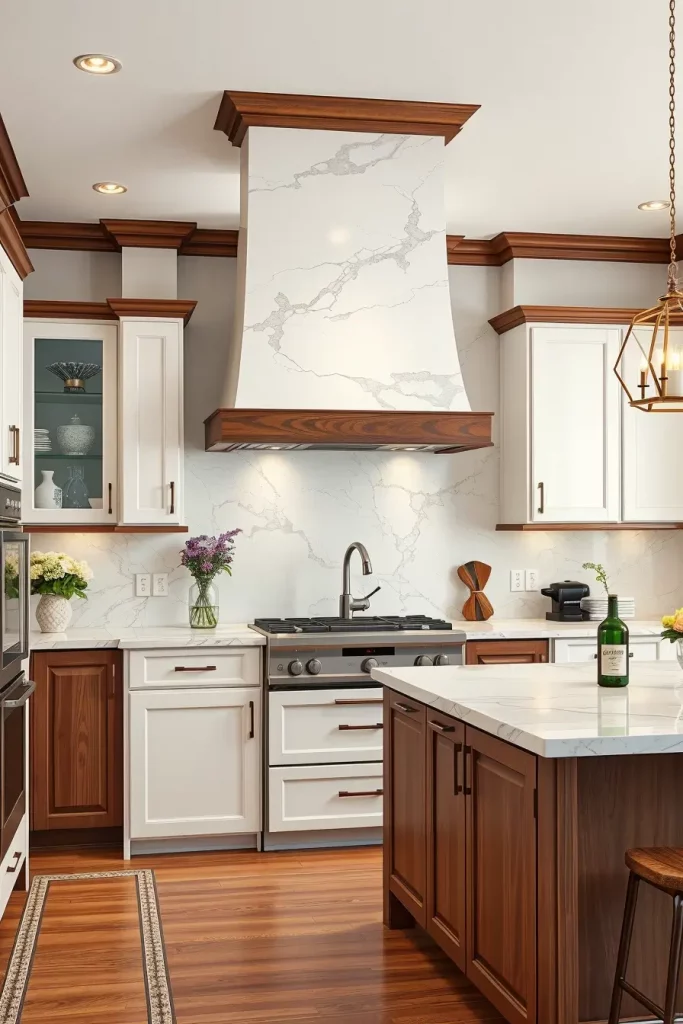
What materials you use on your hood will ultimately determine how it looks. For example, this marble backsplash complements brown cabinets perfectly with its walnut trim on a white plaster hood. Additionally, metal hoods also look nice when done in bronze or matte black against brown cabinets or even white walls. I learnt that shapes layered—whether tapered or angular silhouettes—make them sculptural feeling custom made ones.
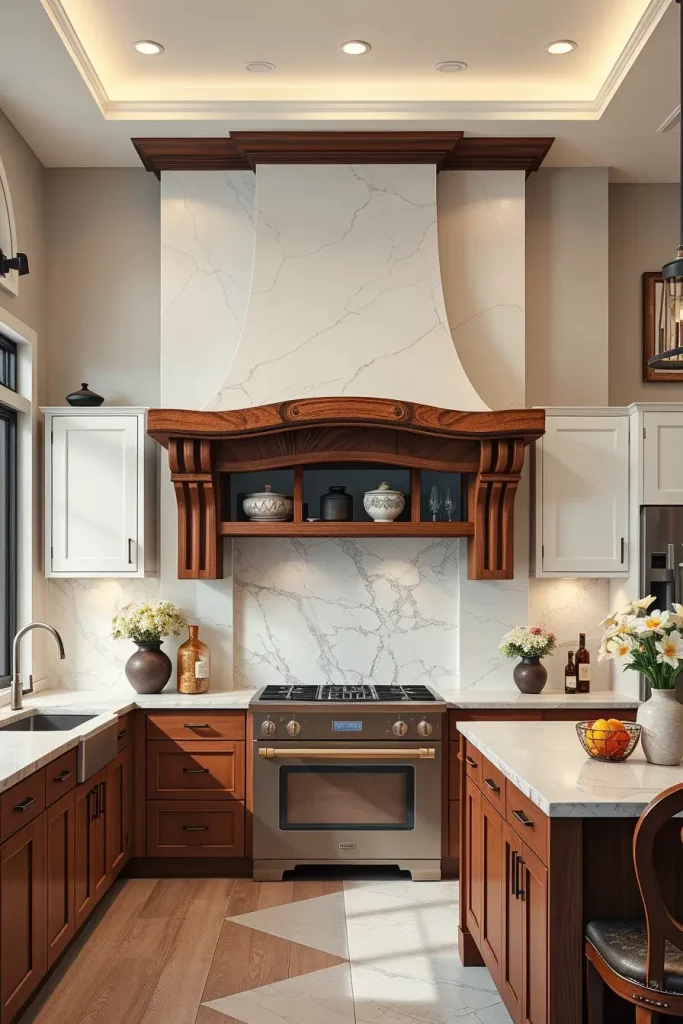
A recent kitchen design I did had hammered copper range hood framed by clean white tiles instead of wood paneling. It was so beautiful that it was more like an artifact! There are some publications popular among interior designers such as Veranda magazine that argue about artistic hoods being among the top trends in bespoke kitchens.
To add to this section, it may be beneficial to provide an explanation about venting systems that give room for design flexibility—recirculating alternatives, by way of illustration, allow you to choose hood shapes without worrying about exterior ductwork.
How Brown Cabinets and White Shelves Create Balance
One great method of achieving this is through combining brown cabinets with white shelves. This can be especially effective in kitchens where effective use of space must not sacrifice visual openness. What I usually do is put up brown cabinetry beneath and white open shelves above so the upper cabinets won’t feel too bulky.
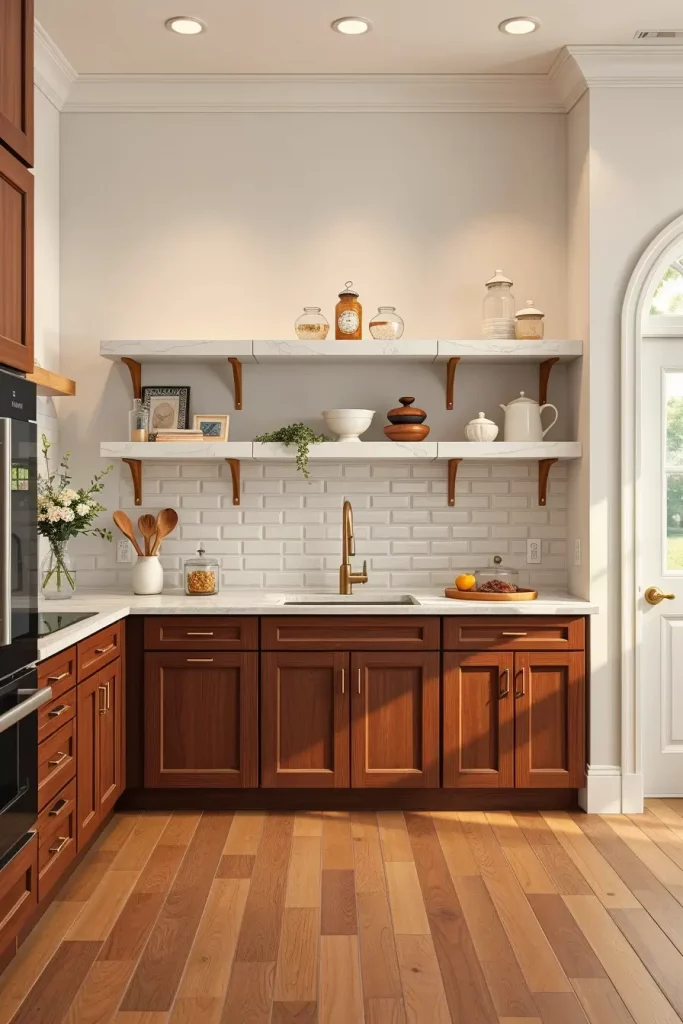
Based on your preference, the shelves could either be floating or having brackets. Personally, I love solid wood white shelves with brass or iron brackets for a more anchored and directed look. These enable occupants to exhibit their china ware, flower vases and/or framed pictures thereby giving some personality without making the place overcrowded. Below them, there are also brown drawers or cupboards with lots of storage space as well as maintainability.
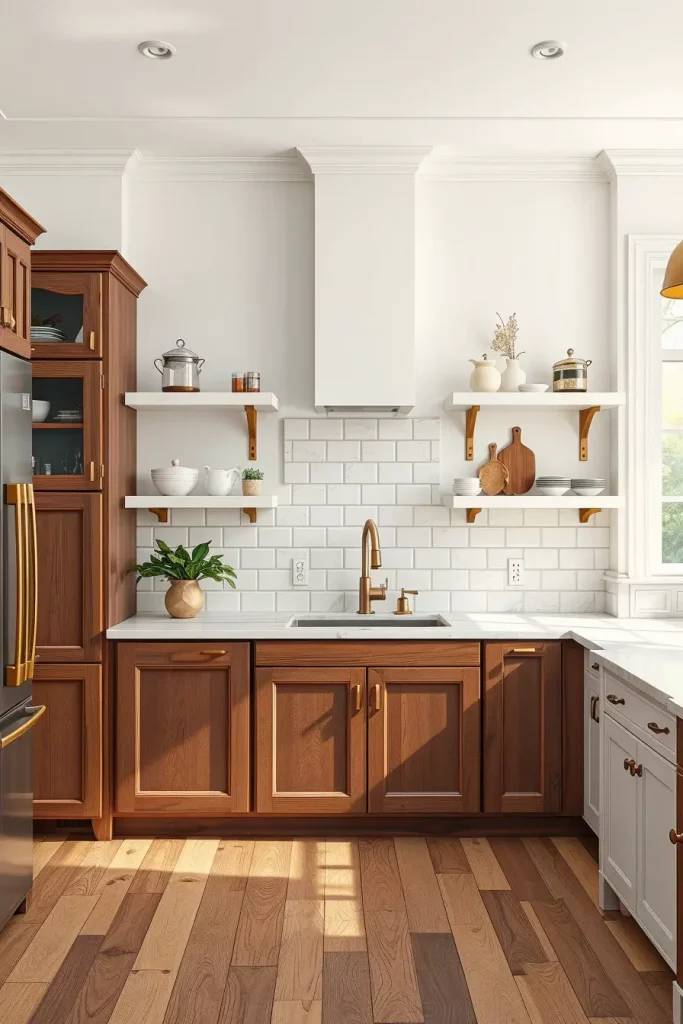
In my experience, this fusion is suitable for small kitchens that might otherwise feel too confined in terms of overhead storage. A client from Los Angeles said that this design made her space appear “brighter, more intelligent and more together.” For example, Southern Living often features the right proportions as a way to modernize country kitchens and make traditional layouts feel more contemporary.
To get the full experience, I would recommend integrating several LED strips beneath the shelves to create mood and highlight the displayed items.
Brown Kitchens With Touches of Black for Drama
Adding black touches into brown kitchen gives it depth immediately. Whenever clients need something bold but still want to maintain warmth, I have tried using it. In fact, think of black as a period at final sentence—it defines and sharpens the area.
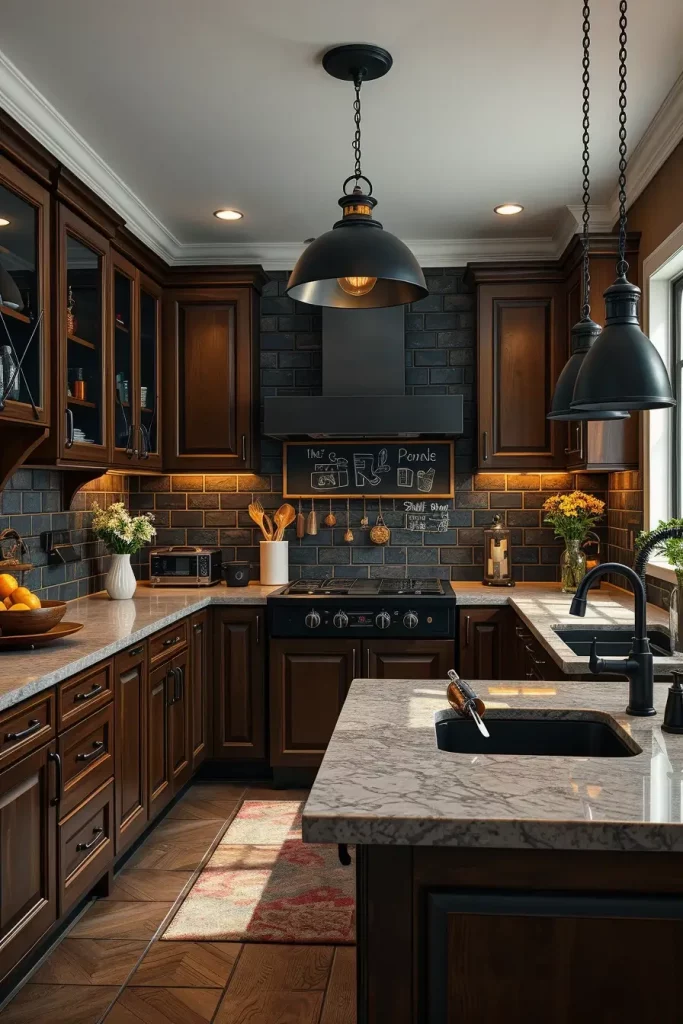
I often suggest matte cabinet handles or pendant light fixtures which are finished in black as well as dish washers colored this way. Walnut or chestnut brown shaker cabinets are ideal for creating background for such accents. On the other hand, a good option is having a chalkboard panel on one side of your breakfast nook with dark feature wall giving you practicality with style.
Initially, a recent customer in Chicago had reservations about black. Nevertheless, we installed a matte black range and hardware against her cinnamon-colored cabinets and it left her awestruck as transformation took place. The website House & Home refers to this as “new neutral layering” where the color black in combination with warmer palettes provides equilibrium and maturity.
To complete the look, experiment with black-framed bar stools or try out a metal framed pantry door with frosted glass for that extra touch of architectural structure.
Accent Walls in White for Depth in Brown Spaces
For kitchens that are heavily brown-oriented, adding a white accent wall is a great way to create visual breathing room while also providing contrast. I do this by breaking up dark cabinetry or dense wall-to-wall textures. Painting just one wall white—especially behind open shelving or around a window—can give you zones and reset the palette.
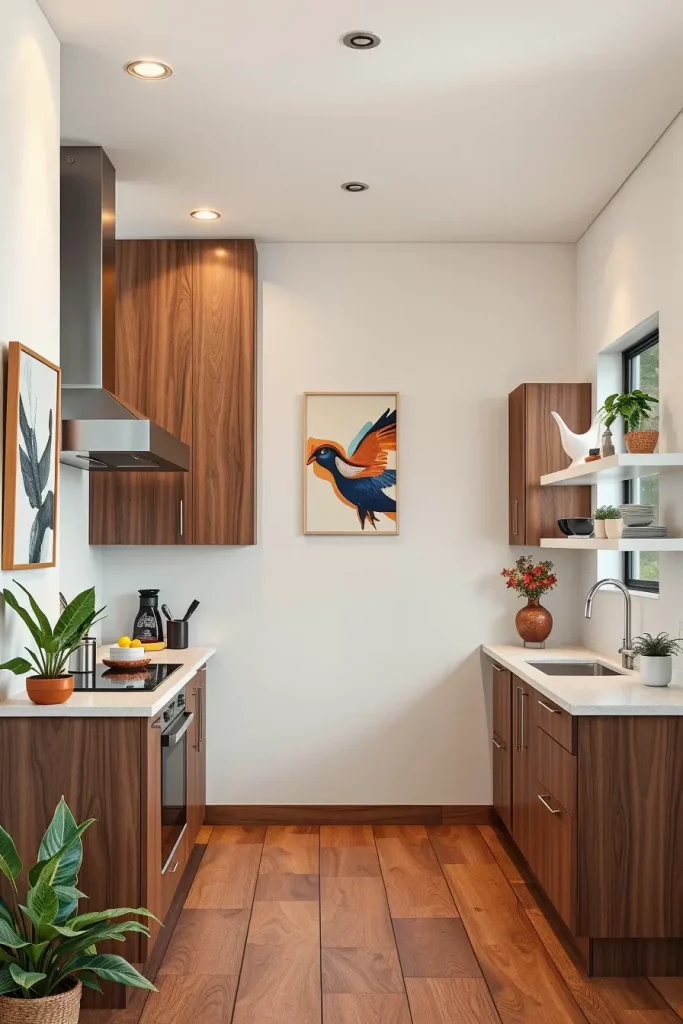
In terms of design, I would suggest using satin or eggshell finished white paint that reflects light gently. Choose warm whites or creams instead of stark bright whites which appear too clinical. A big piece of art or clock on it makes it into focal point without any need for other furniture units.
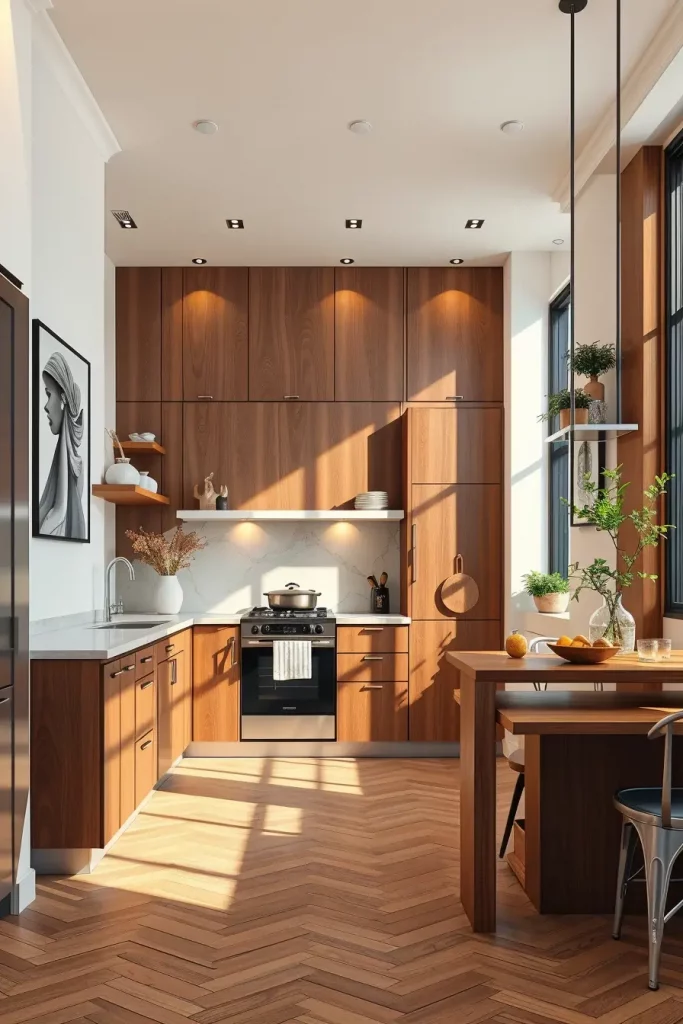
Several times in my design portfolio, I have experimented with this approach especially for loft-style kitchens and the outcome was excellent. One of the residents stated that it “expanded their view” visually, featuring a more prominent cabinets than before.” Real Simple Magazine suggests that white accent walls help to break away from richer colors and keep kitchens clean and up-to-date.
If I were trying to add a little bit more, I’d suggest putting up some textured decorative white tile on the accent wall – maybe some sort of herringbone or hexagonal pattern for just a hint of movement.
Timeless Elegance With Brown and White Tilework
Brown and white tiles are a classic design choice for numerous reasons: they introduce pattern, create contrast, add grace to any kitchen. I prefer having my floor or backsplash in tiled form with geometric or repeating motifs which talk back to both colors creating harmony. This last method gives it some personality without taking over the whole room.

Sometimes I choose checkerboard patterns, Moroccan designs or even straight lines using brown ceramic tiles and white porcelain or marble tiles. With regards to layout options, one can use grout colored mid-tone taupe as well; this is able to hold everything together. In galley style kitchens especially those where width is paramount floor tile is most effective.
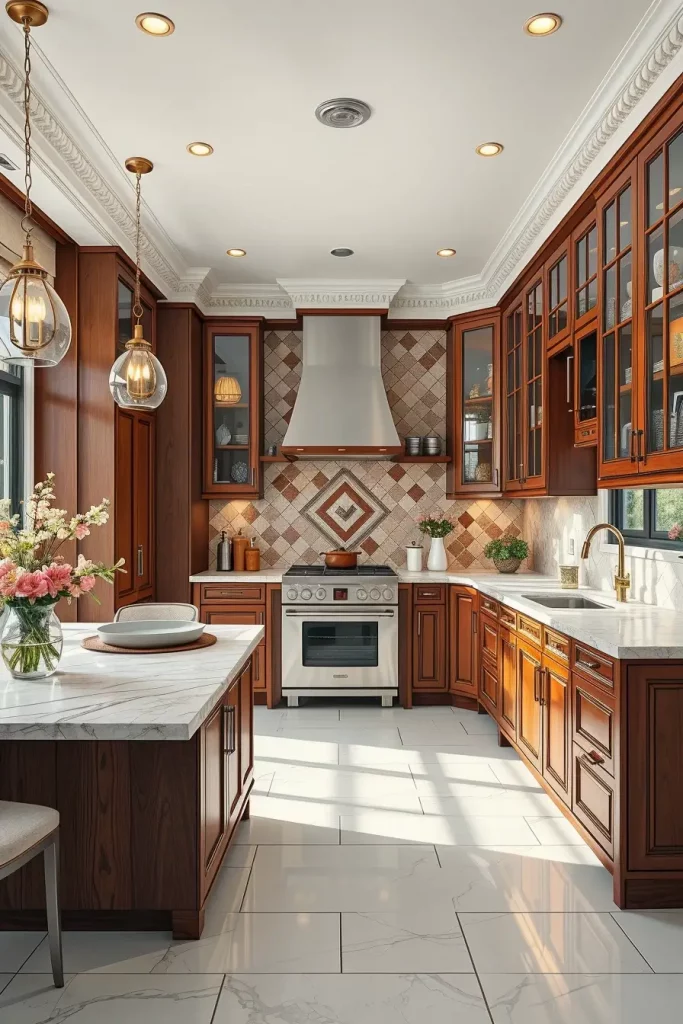
I have seen how even budget tiles can be made to look like pricier ones. One of my clients used a brown and white hexagonal tiles in her bungalow kitchen and it completely changed the feel of this space. Apartment therapy too has picked up on this—thus, tilework is one of the most versatile design tools for kitchen makeovers.
If there is an opportunity for expansion; I would explore vertical applications of tile other than the backsplash—maybe even full wall cladding beyond open shelves or range hoods for a maximum visual effect.
Natural Stone and Wood Combinations in Brown Kitchens
Combining natural stone with wood in brown kitchens creates depth, authenticity, and an earthy richness that’s hard to beat. I tend to pick materials that are unpolished or slightly processed—like honed granite, travertine, or tumbled marble paired with natural or stained oak, walnut, or maple cabinetry.
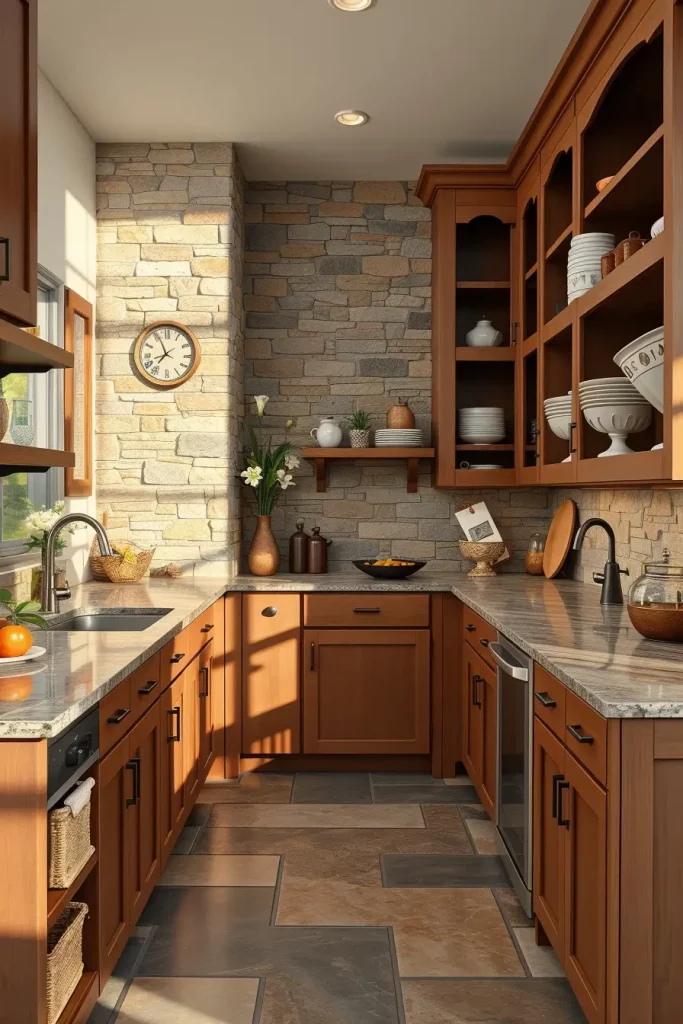
To bring balance into design I use wood cabinetry as the base and incorporate stone as countertops, flooring, or backsplashes. In a recent project we created a moody spa-like tone by combining rough-cut slate tiles on the backslash with mahogany cabinets—that was both rough but luxurious feeling about kitchen.
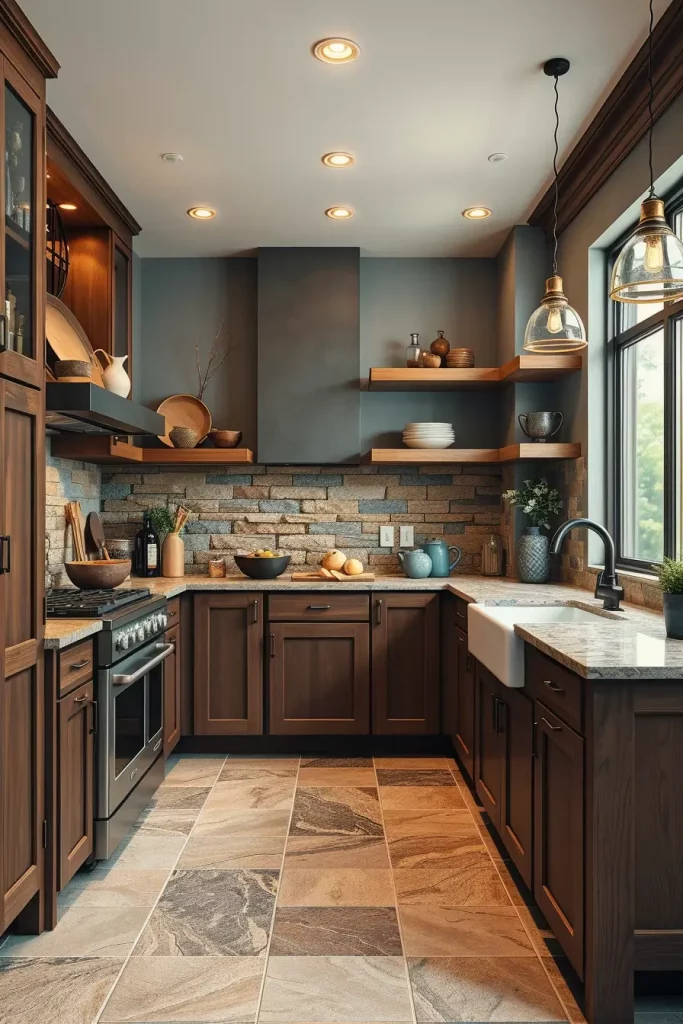
I think this alignment has a professional appeal to home-owners who value naturalness of the materials. Luxe Interiors + Design suggests that more and more designers are pairing stone with wood in order to create warmth and symmetry in modern kitchens.
Another aspect where this section can be enriched is through looking at how sealed stone slabs blend into dining counters or waterfall edges, thus creating a smooth transition from preparation to serving areas.
Unique Hardware Finishes for a Custom Brown Look
For me, hardware can make or break a brown kitchen design therefore I always advise clients to try unique finishes which can accentuate the tone of timber. How about aged brass, matte copper, oil-rubbed bronze or even brushed black nickel? Each creates different feelings – from country-like to contemporary to elegant.

If cabinetry is darker shades of brown, lighter hardware will provide contrast; medium ones look great with monochrome finishes such as bronze or chocolate brass. In one of our recent remodeling projects we took advantage of custom leather loops and brass rod pulls — it was quite an icebreaker. Handles could also be inset, oversized, or sculptural in nature depicting the newer trends.
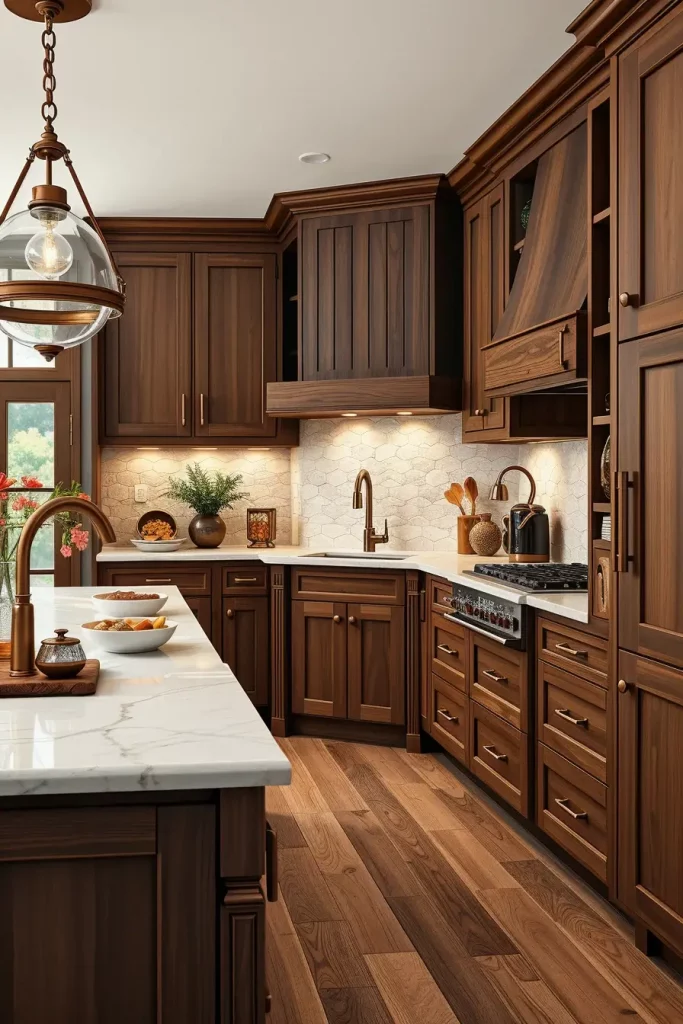
Me? I personally love mixing finishes in one room. If you’re worried about things looking disjointed, try using a matte bronze faucet with burnished brass pulls for some depth. Emily Henderson referred to hardware as a piece of “jewelry for the kitchen” and I’m in total agreement– it is such a small change that really makes a lot of difference.
As an additional point, I would include a section on sourcing – local metal artisans or Etsy sellers can have unique hardware that isn’t available at big box stores which adds another layer of individuality to your design.
Open Shelving White Accents For Brown Kitchens
Based on my personal experience, brown kitchens with open shelving and white décor provide an interesting equilibrium of earthy and brash features. The deep chocolate hues are warm and inviting while the whites add a sense of lightness. This approach works well in both small apartment settings and spacious homes; the decor creates a sense of order while also making the space feel welcoming. It is ideal for anyone wanting to showcase dishware and decorative items while maintaining a clean aesthetic.
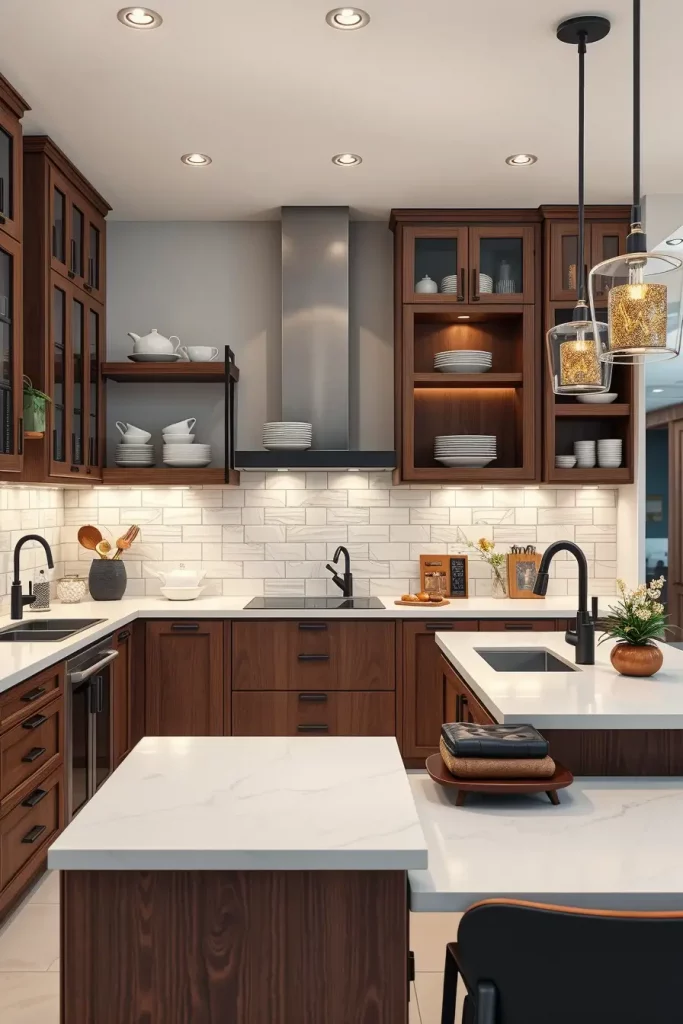
Deep brown cabinetry combined with floats shelves in lighter walnut or chestnut look best with white accents. White decor elements can be integrated with quartz countertops, subway tile backsplashes as well as ceramic tableware. Contrasting gold or matte black fixtures add class. The wall also needs to be kept light, soft white or warm cream works best in order to brighten the space. Open shelving makes sure that frequently used items are easy to grab and also allows for decorative overflow.
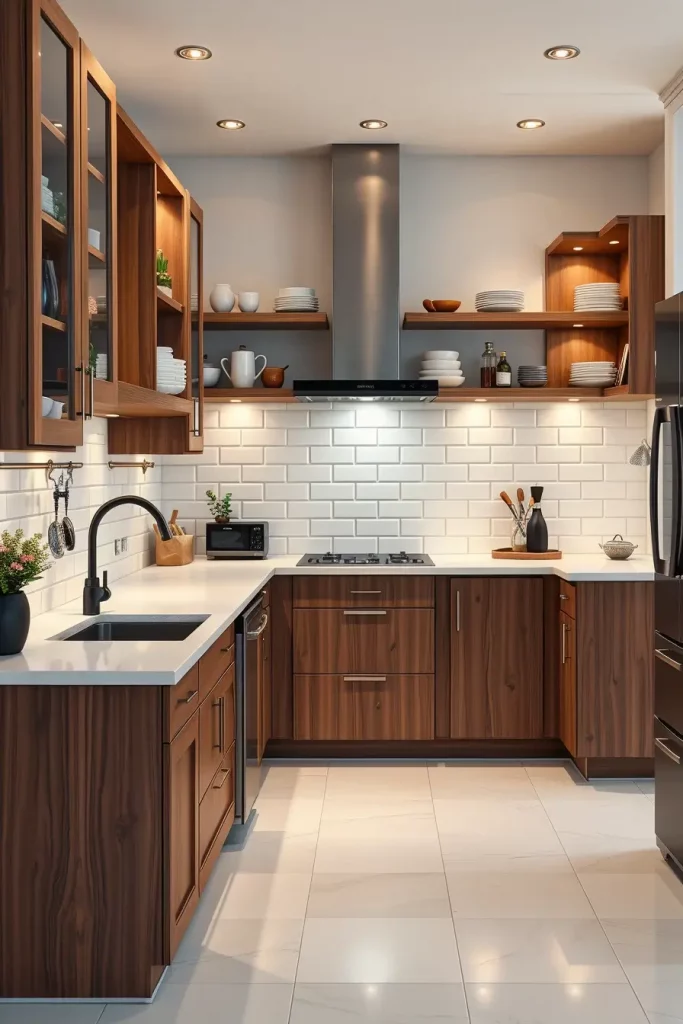
This is one of my favorite layouts for smaller spaces — particularly when you want to avoid the claustrophobic boxy feeling. Better Homes and Gardens points out that open shelves in darker kitchens are one of the best ways to enhance a spatial illusion and visual movement within the room. I also feel that this combination is modern yet timeless when done with intention.
To this setup, I would add mood lighting in the form of LED strips under the shelves, glass jars for loose dry goods, and soft touch greenery to the mix. A white ceramic or light wood paired with the flooring also ties in the theme perfectly.
Layered Neutrals: Beige, Cream, and Chocolate Harmony
A kitchen with a warm and welcoming vibe can easily be achieved with a layered neutral scheme of beige, cream, and chocolate brown. In family homes or spaces that see a larger footfall, I find this palette particularly appealing. The gradient of colors brings a sense of calm while providing a richness in texture often absent in monotone schemes.
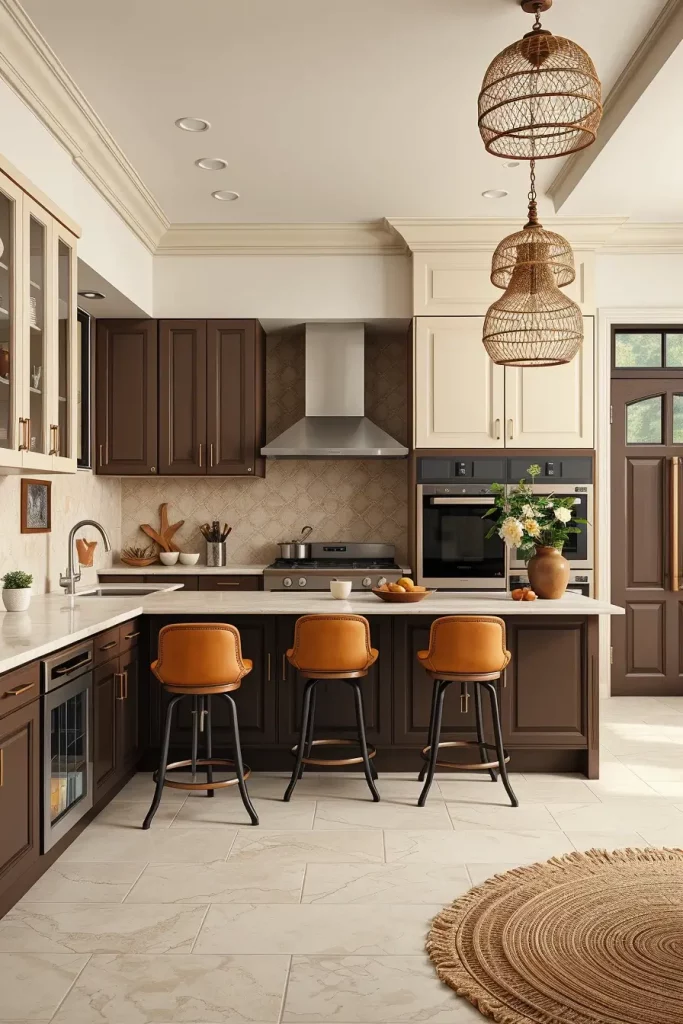
For this trio, I tend to chocolate brown the base cabinets, use cream or off-white for the upper cabinets or walls, and beige for the floor or island. This layering adds visual softness and depth. To blend all the pieces together, a honed marble or travertine countertop would suffice. Upholstered bar stools in beige or tan leather paired with a jute rug under the dining table adds texture and warmth as well.
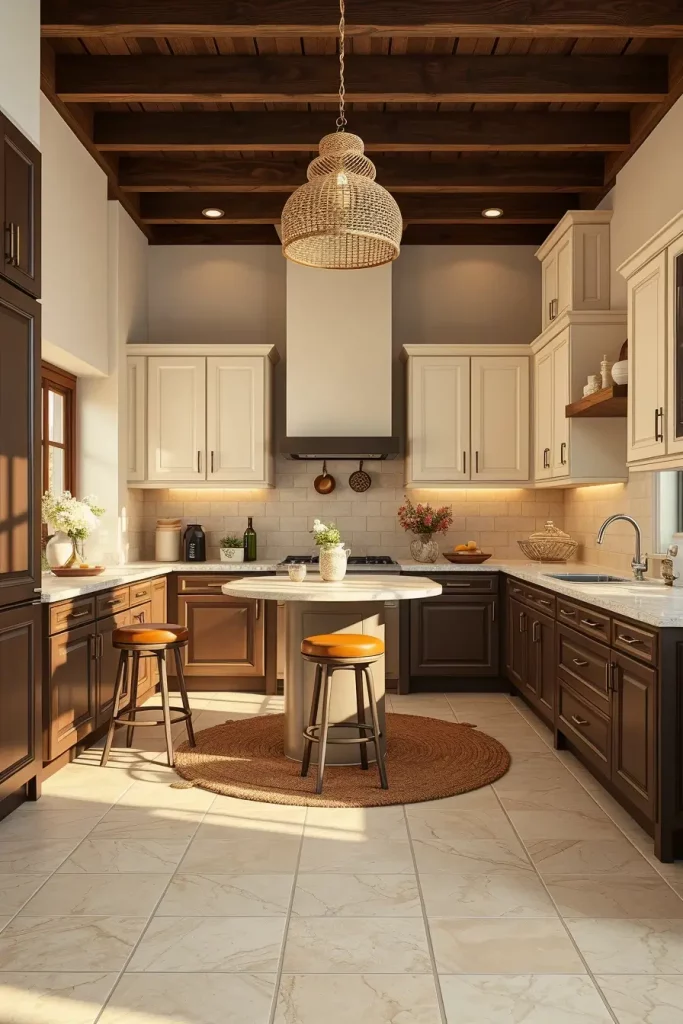
This combination strikes me as quite tangible. It’s understated, yet often feels even more luxurious due to its restrained nature, which is unlike most others. Shea McGee, an interior design expert, strongly suggests this kind of tonal layering for achieving balance in focal spaces like the kitchen.
I would further enhance design unity with the lighting. To complete the look and juxtapose the sophisticated color palette, a pair of woven or rattan pendants over the kitchen island would bring in that final organic touch.
Designing Brown Kitchens With Sophisticated Minimalism
I will say that brown is an underrated choice for a minimal kitchen. In fact, brown can anchor a sleek space beautifully. Instead of using stark black and white minimalism, a brown toned kitchen brings warmth and maturity without clutter—which is a bonus. The trick is using flat-panel cabinetry with clean lines, minimal accessories, and some textures.
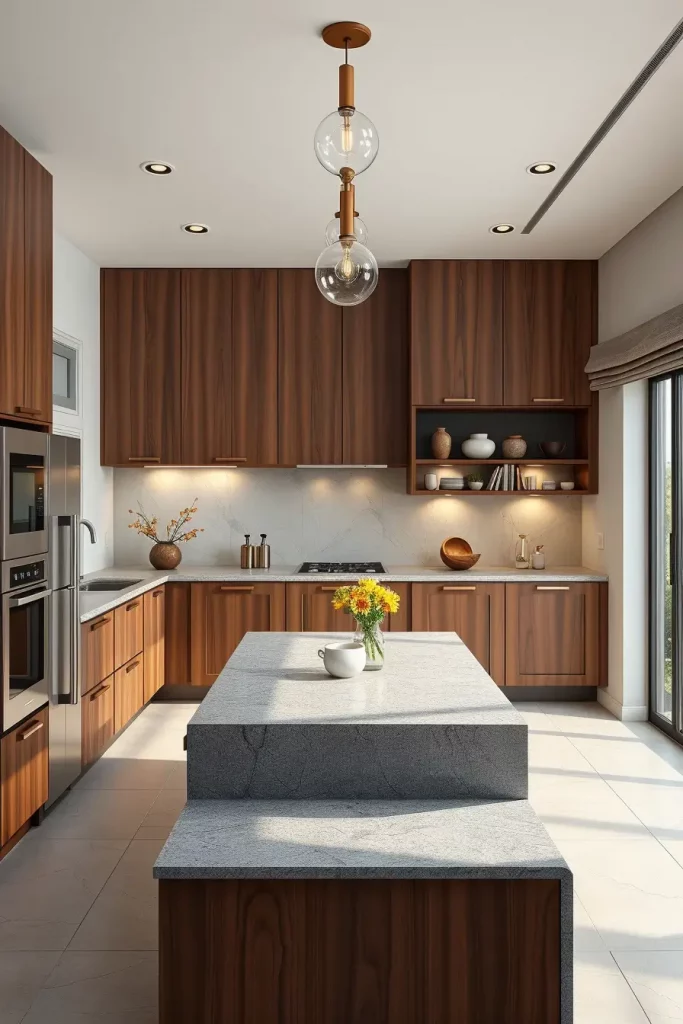
In this setup, I often go for walnut or matte stained oak cabinetry with gray stone or white slabs as countertops. Appliances are integrated to keep the lines clean, and built up surface items with enforced storage solutions helps soften the look. An uninterrupted block of a single tone brown is a powerful mark in interior design. A striking statement on flooring would be smooth concrete or light tile which gives a stark contrast whilst maintaining the minimalistic feel.
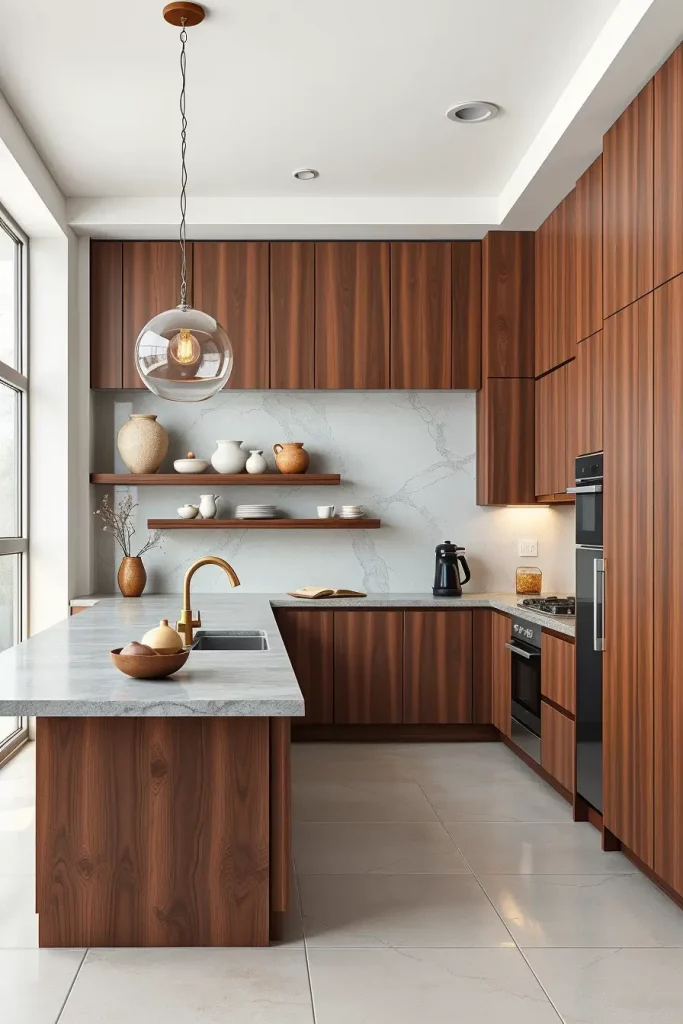
From personal experience, I have designed this type of kitchen in urban apartments or contemporary homes where the clients were looking for modern designs that didn’t feel cold. I feel like I am jumping on the bandwagon, but Architectural Digest did mention that monochrome wood kitchens are flooding the market, mainly in Europe. I see that trend coming to the U.S. too.
Introduce a sculptural light piece, or add an open shelf adorned with curated pottery to further stylize the space. Here, subtlety wihh impactful details is the name of the game.
Brown and White Patterns In Interior Designing Trends
In my vision, sustainably sourced materials, layering of textures, and matte finishes will be brown and white kitchen design themes for the future. Brown kitchens are regaining popularity, particularly within organic modernism, and when coupled with white for balance and light reflection, brown works beautifully. The current focus is shifting from glossy perfectionist aesthetics to inviting imperfection.
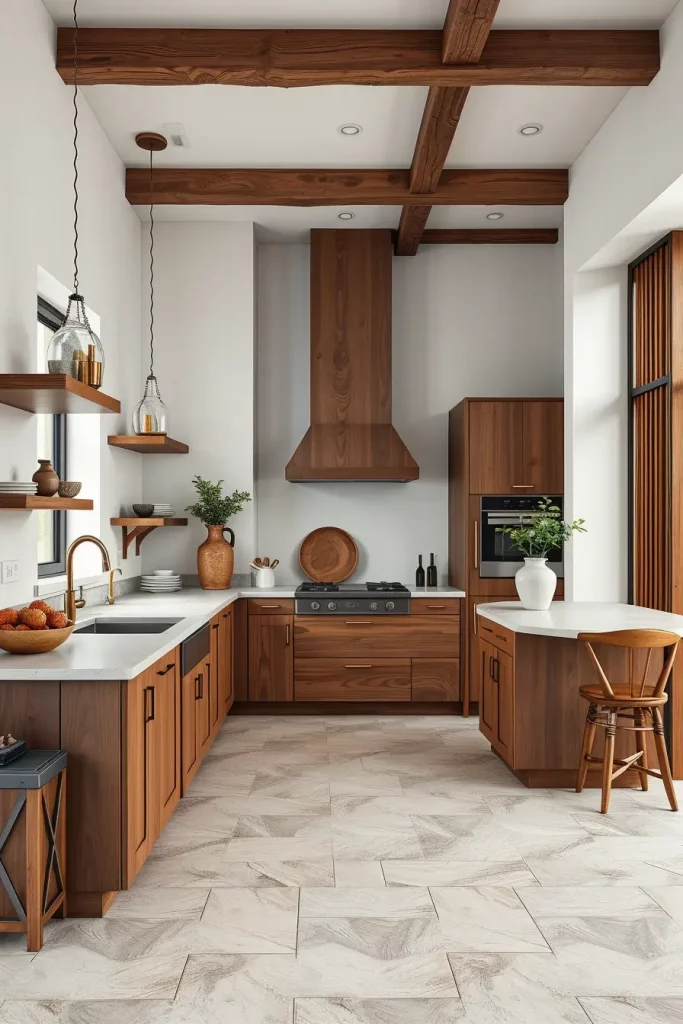
Eyes will soften towards warm taupe or grey plaster walls with cork, natural walnut, or reclaimed wood cabinetry paired with soft edge countertops and rounded islands. Fixture upgrades like bronze or dark nickel also change the long-standing tradition of chrome. Vertical warmth and interest is given through slatted wood elements like partition dividers or ceiling beams.

This design language might not be ideal for everyone, but it is definitely emotionally rich and ecologically friendly at the same time. Studio McGee and many other renowned names are already adapting these materials for both mid-range and luxury designs. It’s the physically responsive nature of the designs that invite and hold people longer, encouraging togetherness and connection through cooking.
An area of advancement for these futuristic kitchens could be the integration of smart technology. Imagine concealed power outlets, hands-free lighting systems, and eco-friendly appliances that blend with the decor. Such innovations might change the definition of luxury in modern kitchens.
